Numerical Study of Extremely Wideband-Modified Biconical Radiation Structures for Electronic Support Measures Application
Abstract
1. Introduction
- The base MBA structure has three bands with VSWR ≤ 2. They are [0.93, 1.23] GHz, [3.97, 5.36] GHz and [6.14, 68.27] GHz.
- By stacking metallic-rings on both circular-ends of the base MBA, three to five bands with VSWR ≤ 2 can be created between 0.4 GHz and 4 GHz, and the locations of these bands can be tuned by changing the number of metallic-rings. This paper only reports the results of equal numbers (3, 6, 9 and 12) of rings that are stacked on both sides of cones. The design can also use the unequal number of metallic-rings for different ESM applications.
- The unique features of our metallic-ring-loaded MBA designs, compared to those of the base MBA, are: (1) the locations of the bands with VSWR ≤ 2 in [3.97, 5.36] GHz and [6.14, 68.27] GHz are not altered significantly; and (2) the radiation characteristics in the band of [6.14, 68.27] GHz do not have considerable changes when a different number of metallic-rings are stacked on both sides of the cones. The only change is the number of bands with VSWR ≤ 2, lower than 4 GHz, and the locations of those bands.
2. Square-Coaxial Line and Its Feeding Structure
- This figure just shows very small parts of the cones, and both cones are extended further, as shown in Figure 4;
- In order to show how the inner conductor is connected to the upper cone, the dielectric material inside the TEM-line shows the same height as the edge of the outer connector in Figure 3a,b;
- In all our MBA designs, the dielectric material is extended outside the TEM-line outer conductor by 0.8 mm, which can be seen in Figure 5a and Figure 13a;
- Finally, although from a distant view, the antenna looks like having a symmetric structure, as shown in Figure 4, all MBA structures in our designs have three minor asymmetries:
- Because of the feed-line, the upper and lower cones are not exactly mirror-imaged with respect to feed-point;
- Since the square-shape of the outer conductor of the TEM-line, the structure does not have rotational symmetry with respect to the phi-angle (defined in Figure 4b) in each quadrant, and;
- Since the 0.2 mm cube is used to discretize curved cone surfaces, it results in the stair-cased outer surfaces of the cones, which do not have rotational symmetry with respect to the phi-angle in each quadrant, as well. This can be clearly observed in Figure 3a.
3. Base MBA Structure, Its Antenna Characteristics and Comparison of the Results Obtained from Two FD-TD Solvers
3.1. Structure and Dimensions
3.2. VSWR and Return Loss of the Base MBA
- Without any dielectric ring and cover, the TEM-line-fed modified biconical structure also has a wideband with VSWR ≤ 2 from 6.8 GHz to 62.3 GHz. However, practically this structure cannot hold by itself as an EM radiation device.
- Once the inner dielectric ring is added, the band with VSWR ≤ 2 is extended to [6.22, 67.46] GHz, which is very close to the base MBA result of [6.14, 68.27] GHz.
- The beginning and ending frequency points of the two bands with VSWR ≤ 2 that are lower than 6 GHz in the three radiation structures, i.e., without any dielectric materials, just having an inner dielectric ring and the base MBA, are [0.95, 1.29] GHz and [3.59, 5.24] GHz, [0.95, 1.29] GHz and [3.55, 5.36] GHz, and [0.93, 1.23] GHz and [3.97, 5.36] GHz, respectively. These indicate that the dielectric cover plays some role, but not very significant, in the locations of two lower VSWR bands.
3.3. Far-Field Radiation Patterns
- All the radiation patterns are normalized to the maximum value obtained from vertical (EV) fields in the current plot;
- All 3D patterns are scaled into [0, 30] dB since the 3D scatter-plot cannot show a negative value. After scaling, any field values less than 0 dB in 3D patterns are set to 0 dB;
- All 2D patterns are scaled into [−30, 0] dB. After normalization, any field values less than −30 dB are set to −30 dB;
- All the 3D patterns are plotted using a 3D scatter-plot. There are a total of 40,962 directions defined by [phi theta] pairs (see Figure 4b), and these angle pairs are obtained from the vertices of an icosphere. This gives close to uniformly distributed directions compared to the UV-sphere [37] defined directions that have much denser directions closer to the north- and south-poles than at the equator. More details of icosphere defined directions can be found in [38,39].
- The 2D radiation patterns at different frequencies obtained by the two FD-TD solvers have an excellent agreement;
- Omnidirectional donut-shaped radiation patterns appear in the band of [0.93, 1.23] GHz, as the wavelength is bigger than the length of the base MBA;
- In the second band, [3.97, 5.36] GHz, the omnidirectional donut-shaped can be observed at the beginning of the band and starts giving ripples, especially in the upper half of the band. It is because the modified biconical structure is about one wavelength at the beginning of the band and reaches about 1.31 wavelength at the end of the band:
- The horizontal polarization (H-pol) in these bands are all 30 dB less than or equal to the maximum value of the V-pol. Hence, there are no H-pol patterns shown on the 2D plots in Figure 10;
- As shown in Appendix A, when the frequency increases in the ultra-wideband, [6.14, 68.27] GHz,
- The base MBA cannot provide a pure donut-shaped omnidirectional radiation pattern anymore, i.e., the V-pol radiation patterns at different phi-cutting planes are different from each other. This phenomenon becomes clearer when the frequency becomes higher, see Figure A1i,j. This is because the TEM-line feed structure and the discretized version of modified cones are not symmetric with respect to phi-angles in each quadrant, and when wavelength gets smaller, these asymmetric structural properties have more inference on the antenna radiation property.
- The H-pol is also increased. Again, it can be observed in Figure A1i,j.
- The higher H-pol may appear at around phi = 30° and 60° in the first quadrant, as the magenta and blue colored patterns are dominant in the 2D plots from Figure A1i,j. Since the radiation structure has 90° rotational symmetry in phi-angle, we can expect that strong H-pol can also occur around phi = (120° and 150°), (210° and 240°) and (300° and 330°) angular ranges in the second, third and fourth quadrants, respectively.
- At the higher frequency end, there are no clear donut-shaped patterns, and many ripples appear in both phi and theta directions. This is caused by the combined effects from (1) the size of the structure becomes much bigger than the wavelength, (2) the asymmetric structural properties discussed in Section 2, and (3) the surface current that appears on the cones create some ring-like standing-wave patterns, which can be seen from the surface current distributions on the upper cones of the base MBA at different frequency points in the ultra-wideband as shown in Figure 15.
- Again, due to the combined effects discussed in the previous item, some deep-notches can appear in theta between 60° and 120°. Figure A1h shows an example.
4. Metallic-Ring-Loaded MBAs and Their Antenna Characteristics
4.1. Structures and Dimensions
4.2. VSWR and Return Loss of Metallic-Ring-Loaded MBAs
- In the [3.97, 5.36] GHz band, the details of starting, middle and ending frequencies are given in the last column of Table 1. In this band, these radiation structures work more in the transition between resonant mode and “traveling-wave” modes;
- In the [6.14, 68.27] GHz band, these radiation structures work mostly in the “traveling-wave” mode, i.e., before the wave reaches the ends of cones, the majority of the electromagnetic energy has been radiated by the modified-biconical part of the antenna. This also can be observed from the surface current distributions on the upper cones of MBAs shown in Figure 15.
- Why the input characteristics of the base and ring-loaded MBAs are almost the same, and;
- Why the radiation patterns obtained from the base and ring-loaded MBAs are similar (this will be shown in the next section) in the [6.14, 68.27] GHz band.The figure also shows that as frequency increases in the [6.14, 68.27] GHz band,
- The main current that contributes to the far-field patterns gets closer to the feed point, and;
- More current-rings or the standing-wave patterns appear on the cones, which cause ripples and even notches in the theta-direction of the radiation patterns.
4.3. Far-Field Radiation Patterns
- When the length of MBA is less than one wavelength, the omnidirectional donut-shaped radiation patterns can be produced with more pure vertical polarization;
- When the length is around one wavelength, the donut shape becomes flatter;
- When the length is bigger than one wavelength, the donut shape is modified with ripples;
- In these plots, the H-pol component is still at least 30 dB lower than the maximum value of V-pol, as the H-pol is not shown in these plots.
5. Conclusions
Author Contributions
Funding
Data Availability Statement
Acknowledgments
Conflicts of Interest
Appendix A. Far-Field Radiation Patterns of the Base MBA in Its Ultra-Wideband
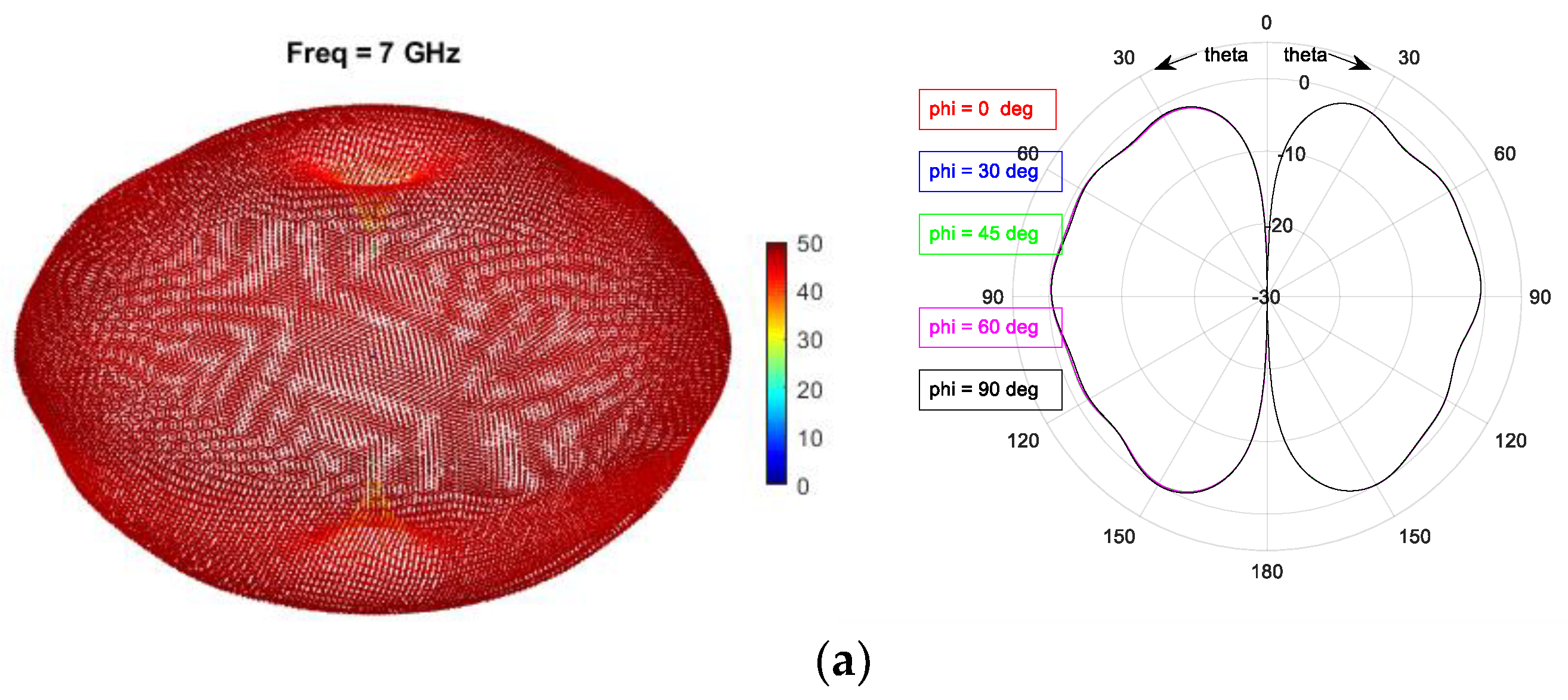
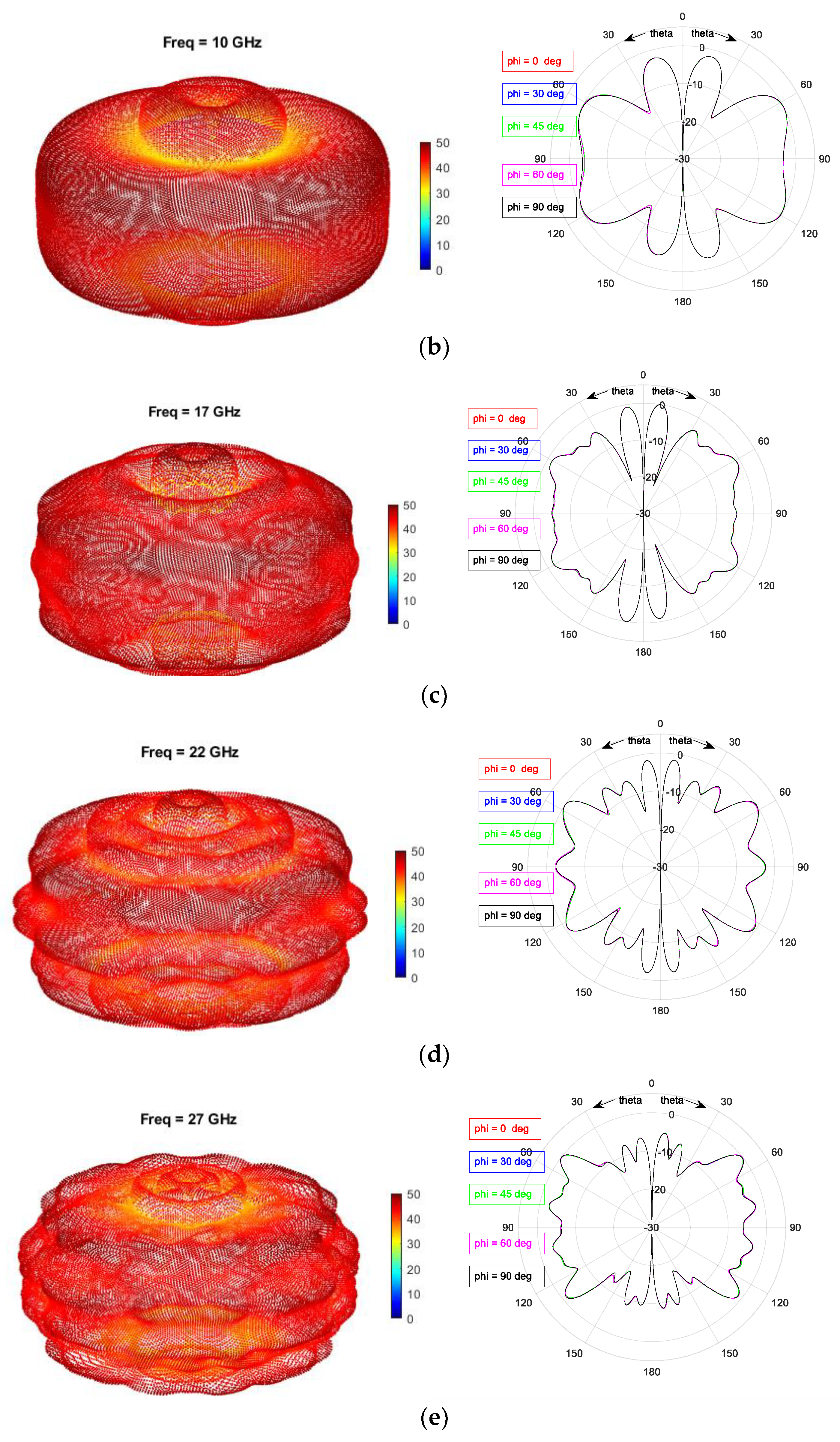
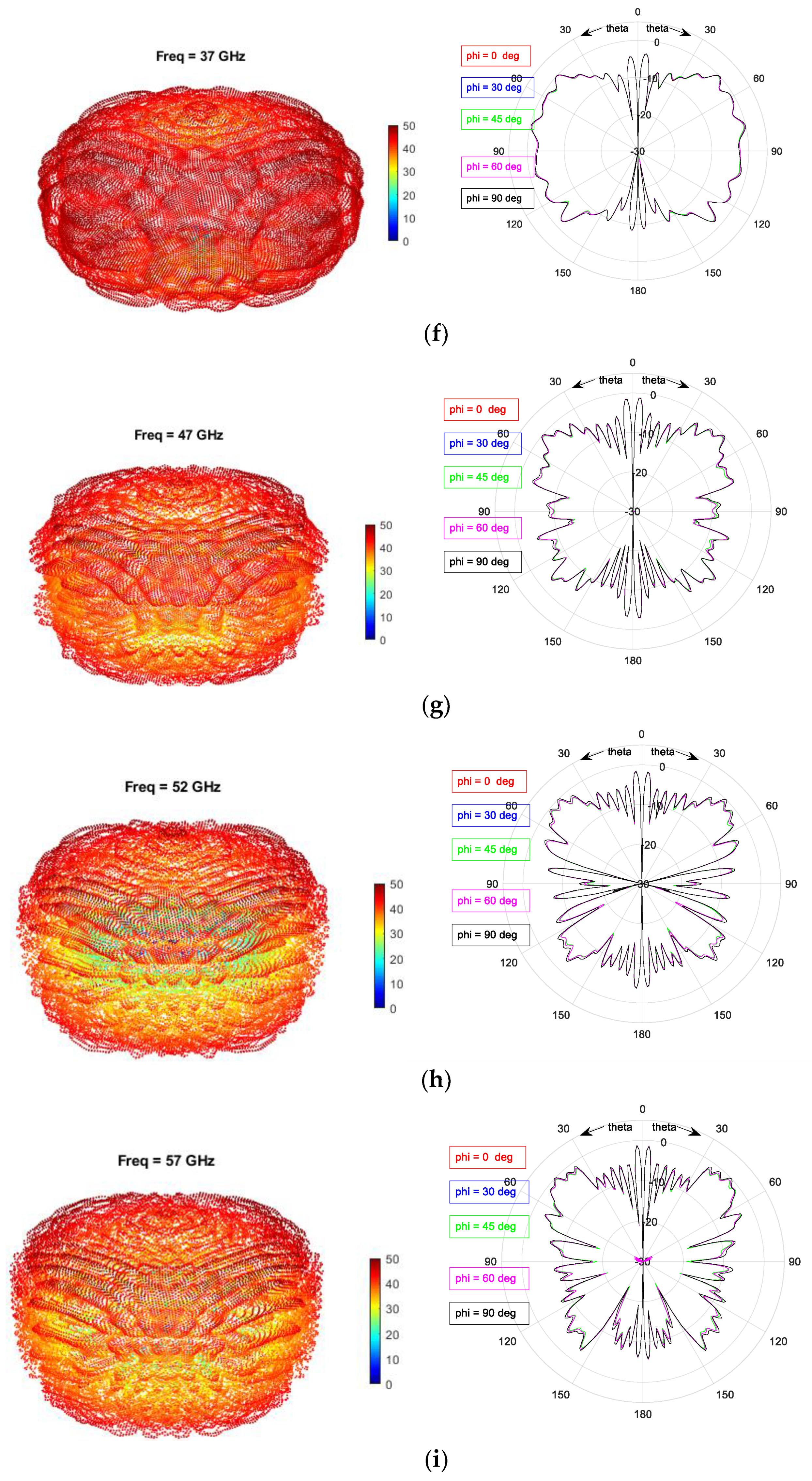
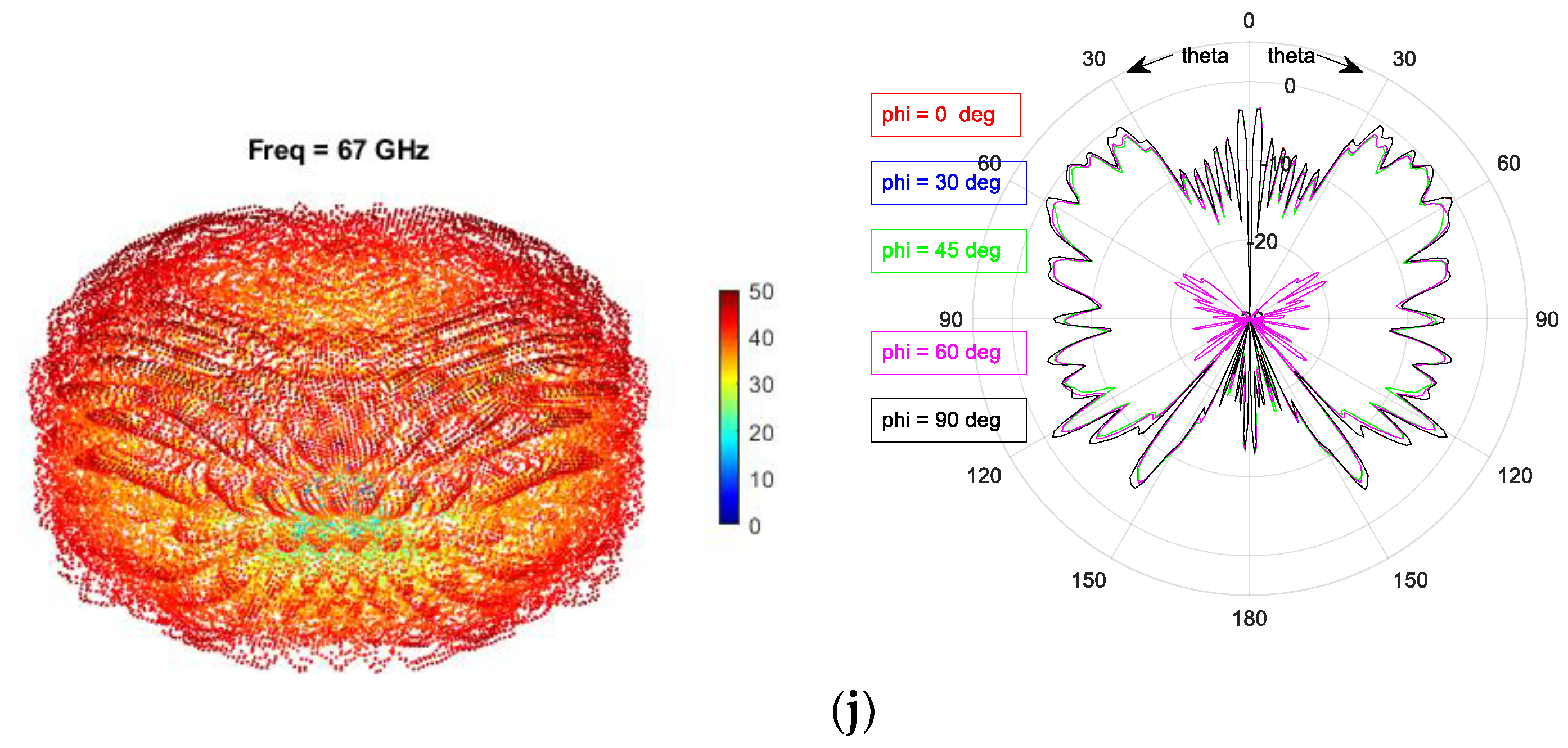
Appendix B. 2D Radiation Patterns of 6-Ring-, 12-Ring-, 18-Ring- and 24-Metallic-Ring-Loaded MBAs from 6.14 GHz to 68.27 GHz
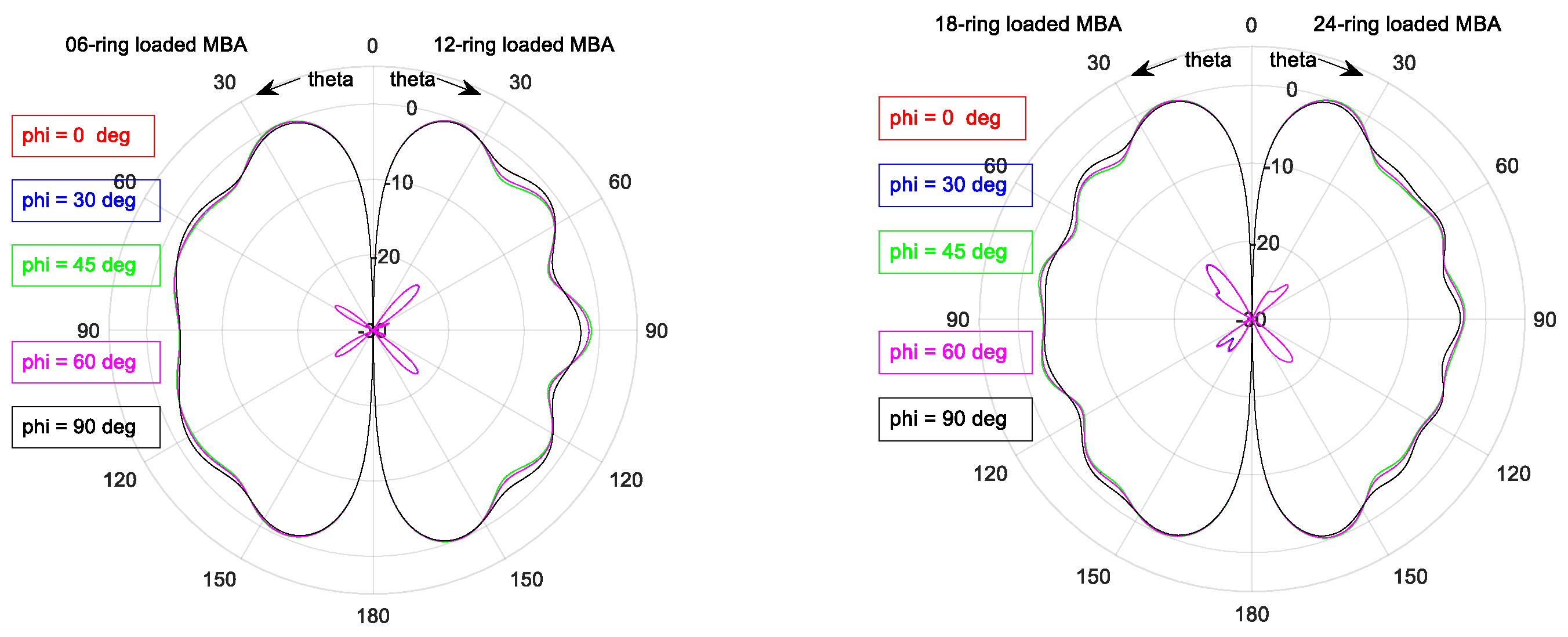
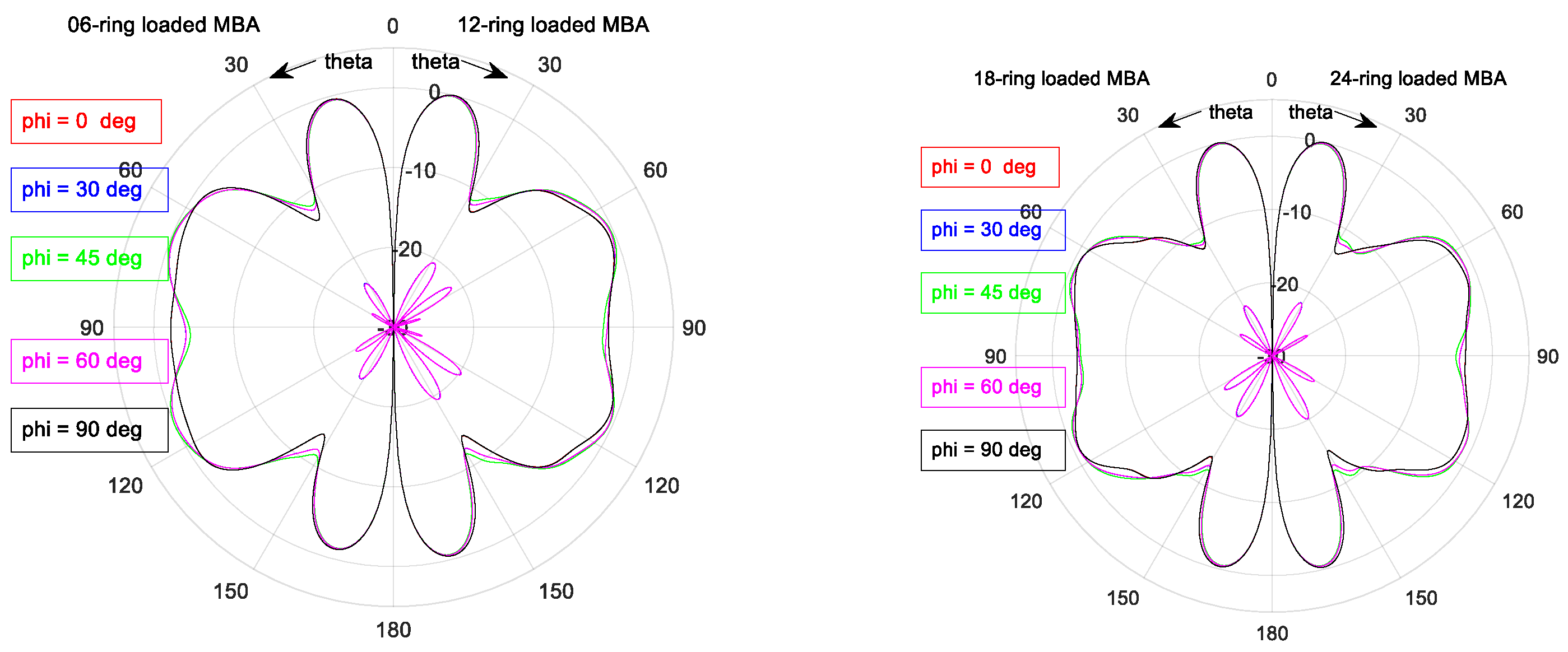
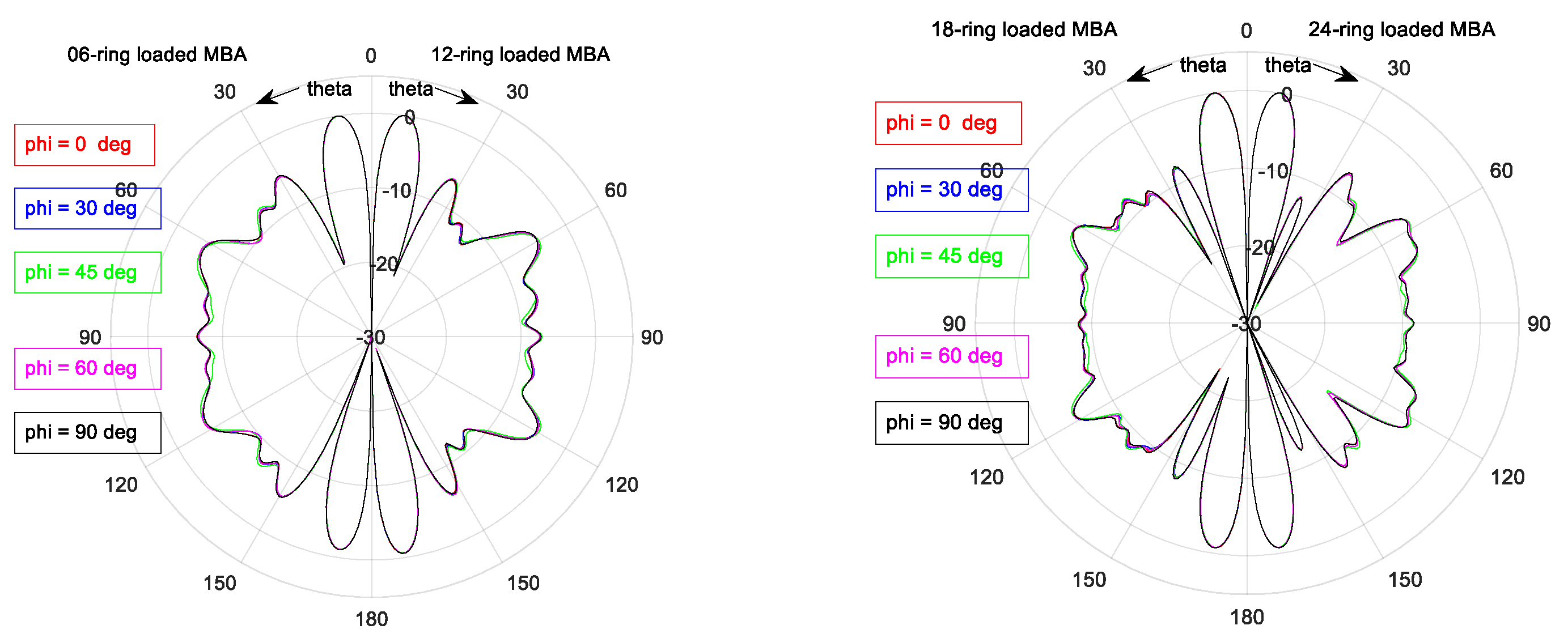
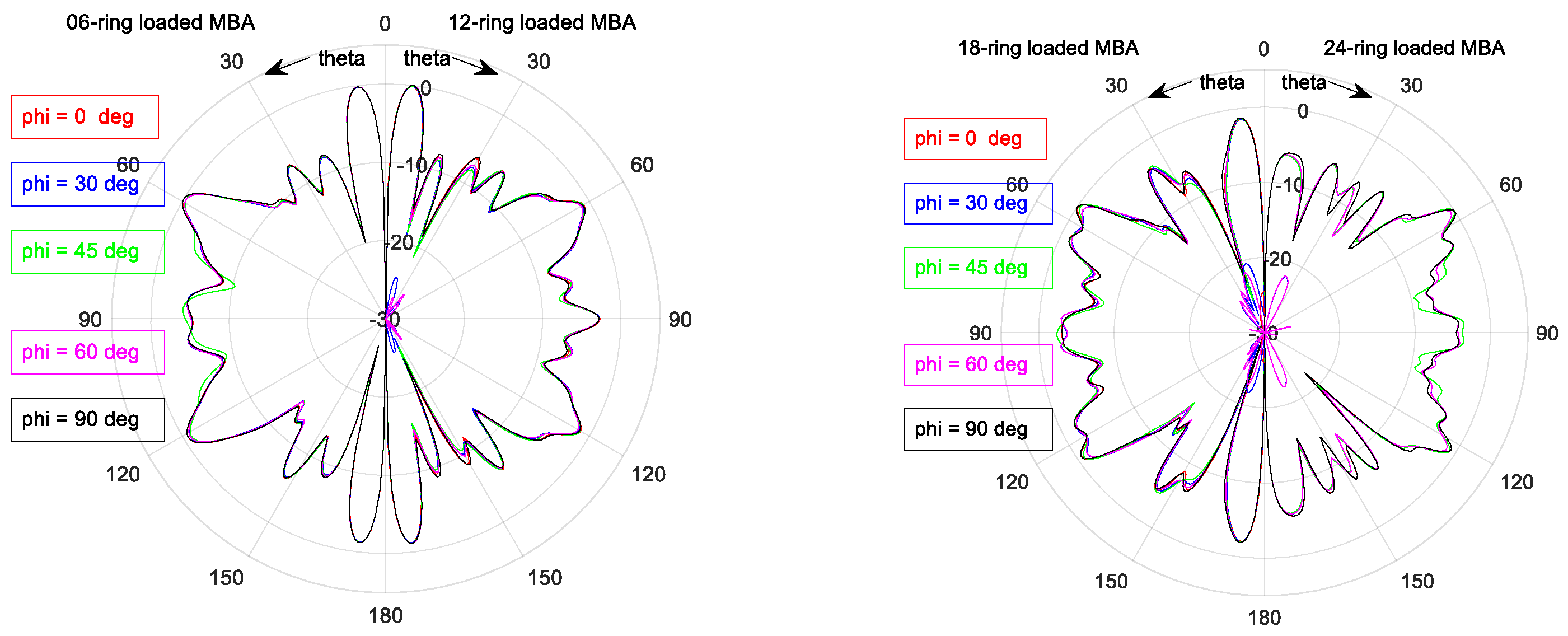
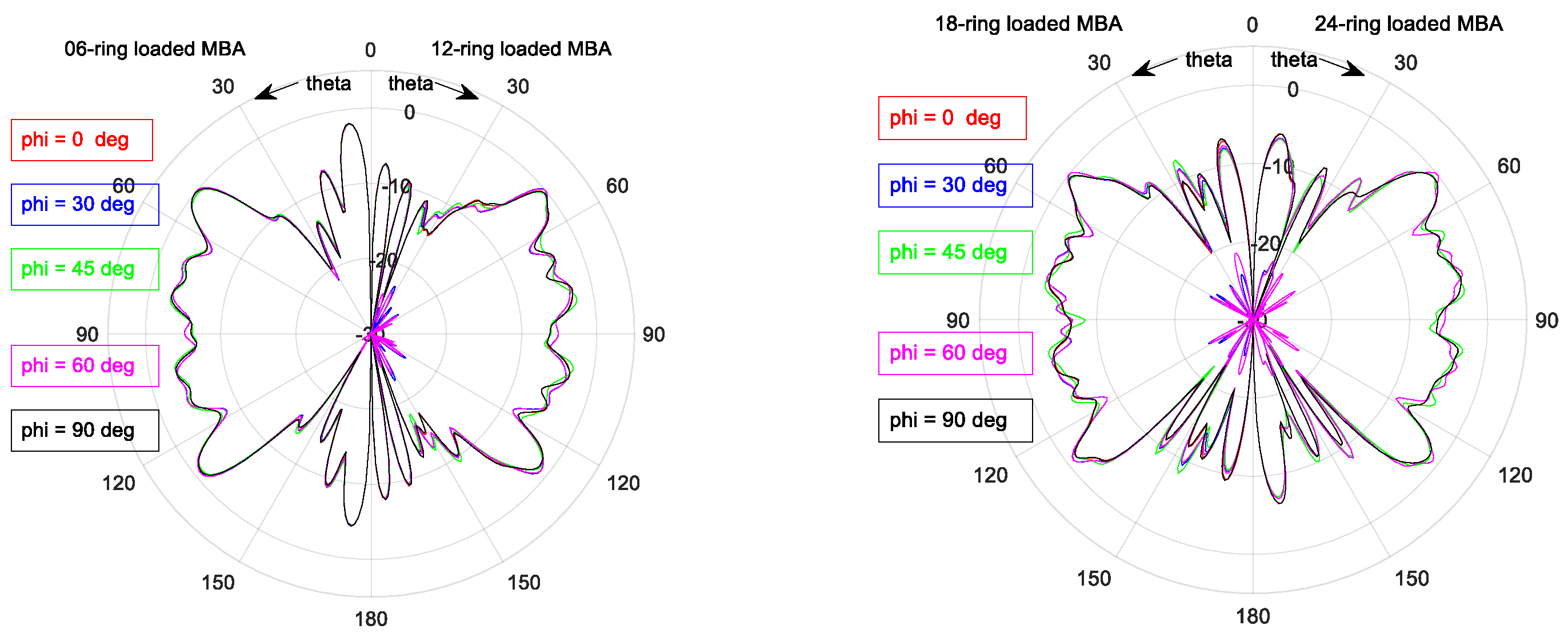
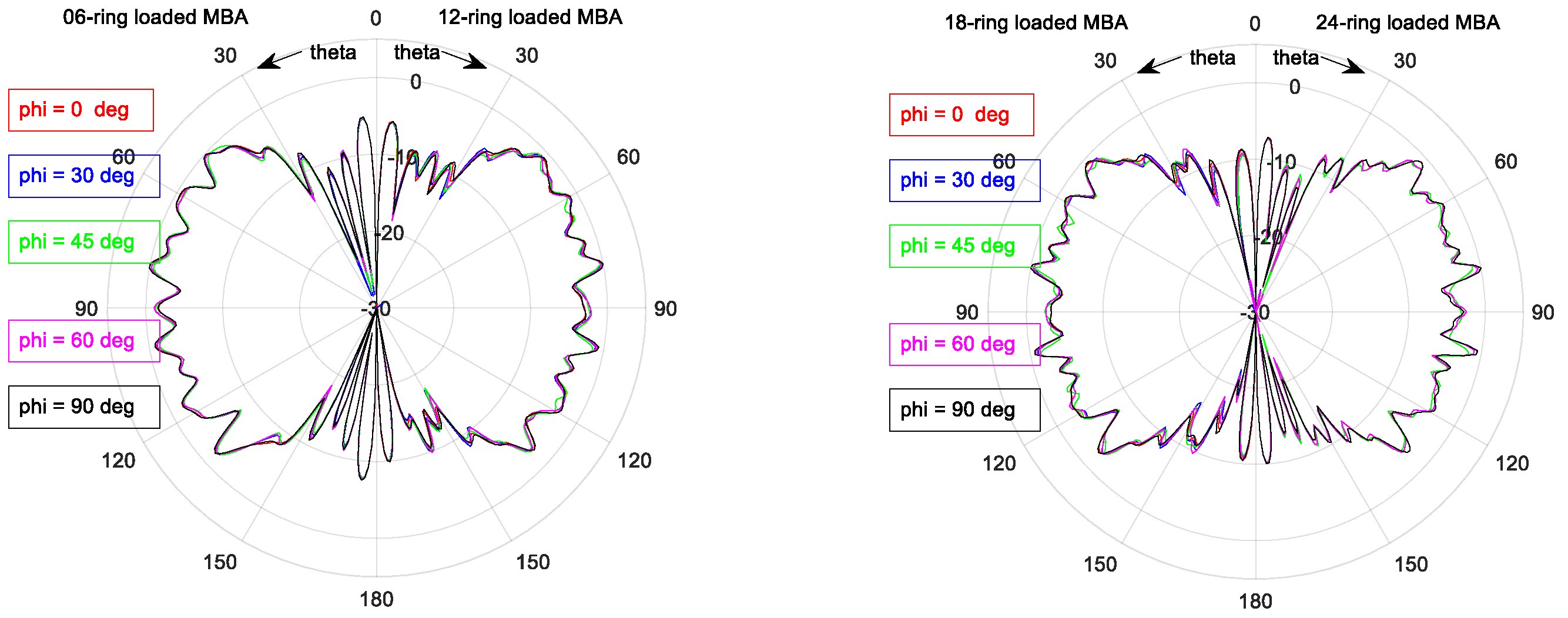
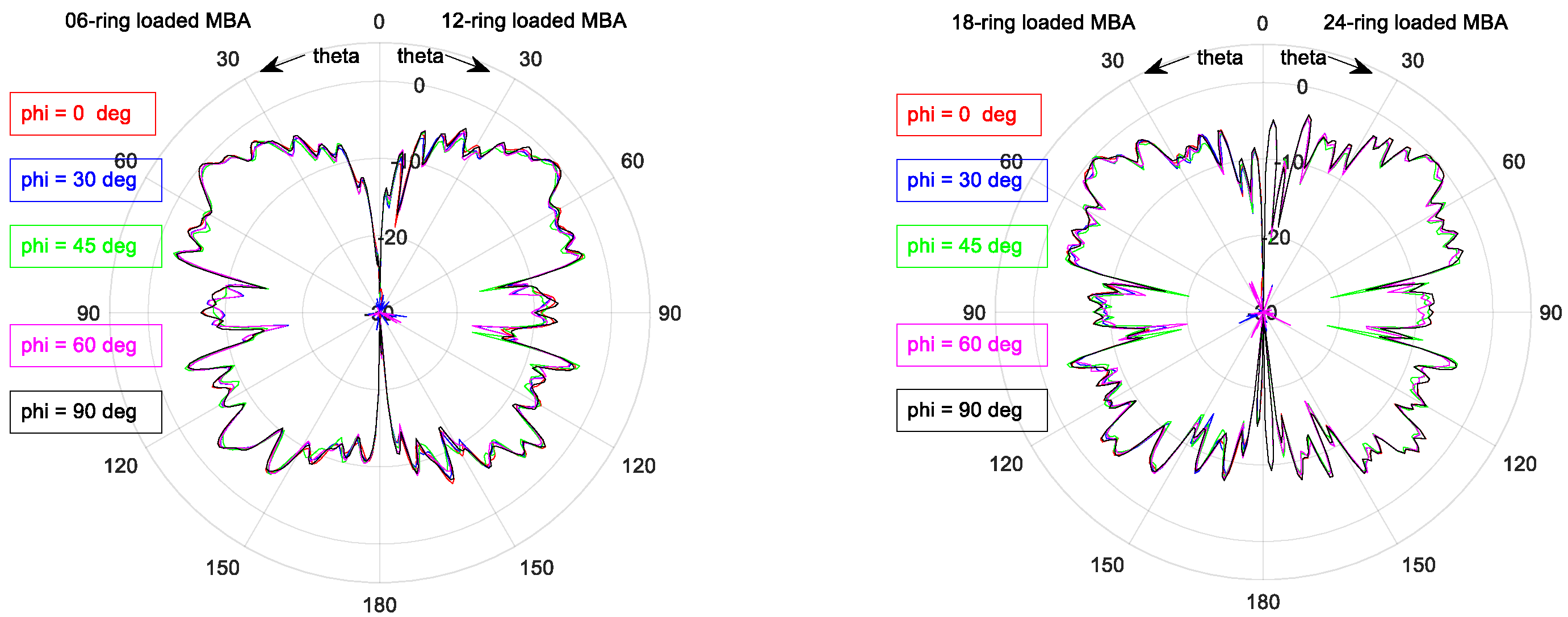
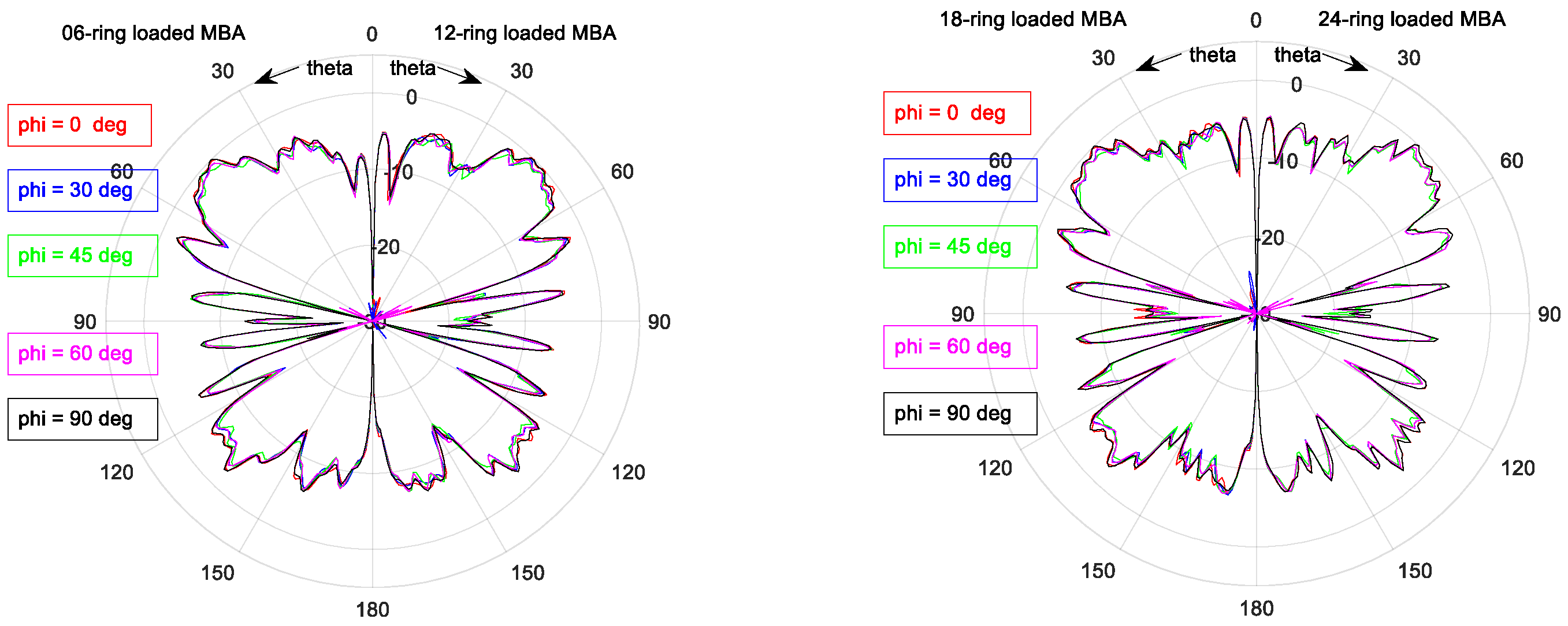
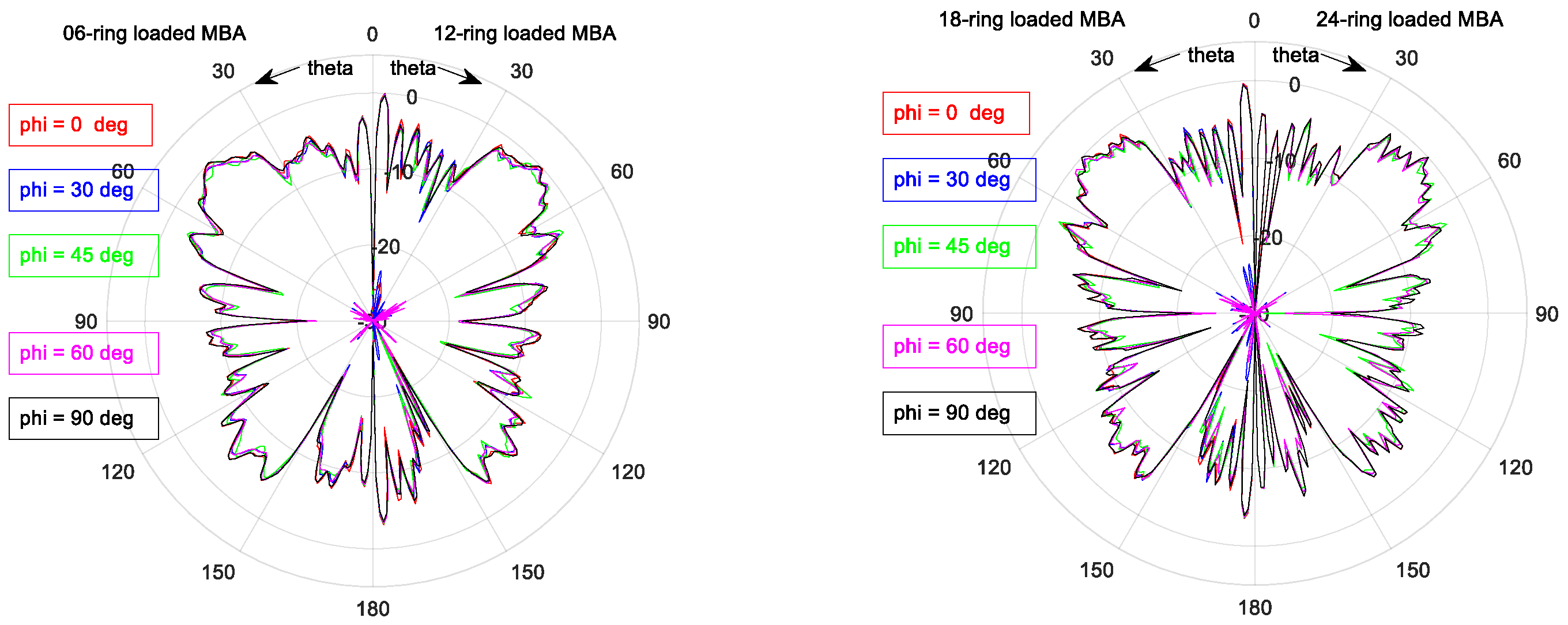
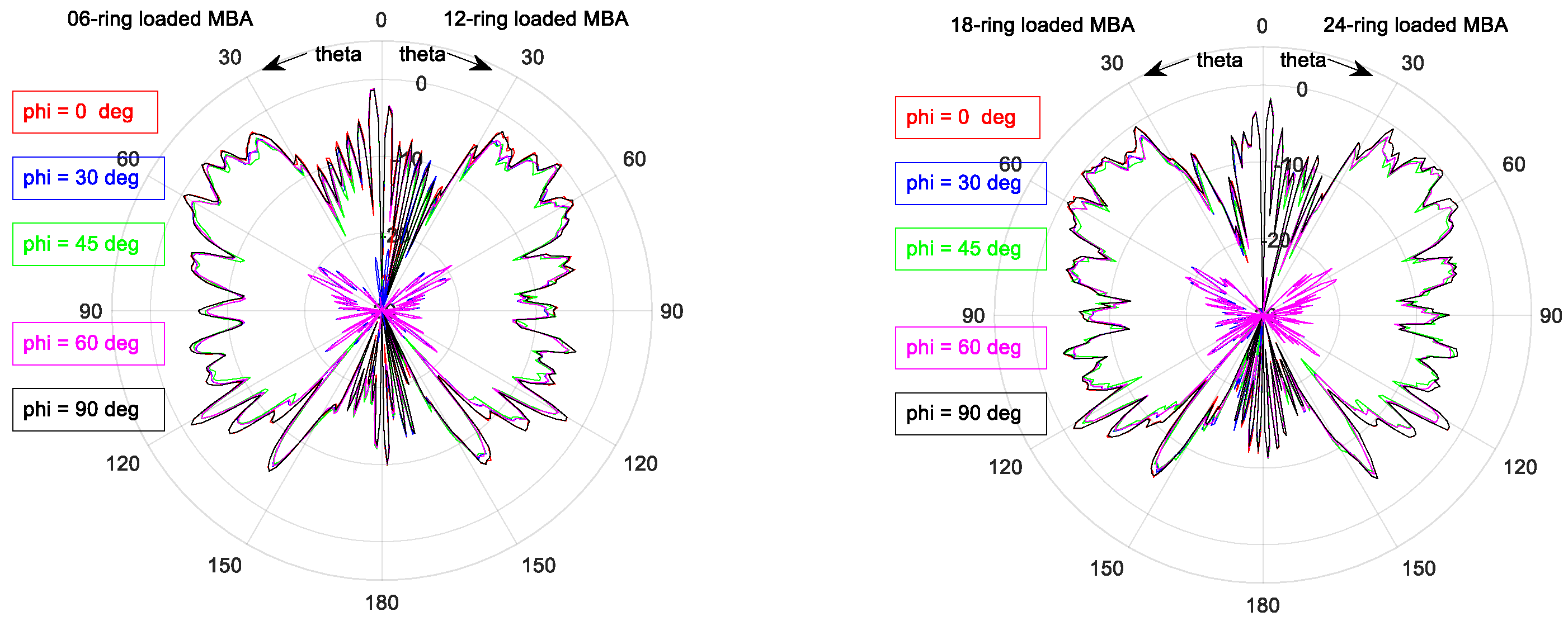
References
- Saeidi, T.; Ismail, I.; Wen, W.P.; Alhawari, A.R.H.; Mohammadi, A. Ultra-wideband antenna for wireless communication applications. Hindawi Int. J. Antenna Propag. 2019, 25. [Google Scholar] [CrossRef]
- Linag, X.L. Ultra-Wideband Antenna and Design; IntechOpen: London, UK, 3 October 2012. [Google Scholar] [CrossRef]
- Lodge, O. Electric Telegraphy. U.S. Patent 609,154, 16 August 1898. [Google Scholar]
- Kudpok, R.; Sachon, S.; Siripon, N.; Kosulvit, S. Design of a compact biconical antenna for UWB applications. In Proceedings of the International Symposium on Intelligent Signal Processing and Communication Systems (ISPACS), Chiang Mai, Thailand, 7–9 December 2011; 6p. [Google Scholar] [CrossRef]
- Liu, N.; Zhang, Z.; Fu, G.; Liu, Q.; Wang, L. A compact biconical antenna for ultra-wideband applications. In Proceedings of the 2013 5th IEEE International Symposium on Microwave, Antenna, Propagation and EMC Technologies for Wireless Communications, Chengdu, China, 29–31 October 2013; pp. 327–332. [Google Scholar] [CrossRef]
- Zhekov, S.S.; Tatomirescu, A.; Pedersen, G.F. Modified biconical antenna for ultra-wideband applications. In Proceedings of the 10th European Conference on Antennas and Propagation (EuCAP), Davos, Switzerland, 10–15 April 2016; 5p. [Google Scholar] [CrossRef]
- Santos, H.; Pinho, P.; Salgado, H. Patch Antenna-in-Package for 5G Communications with dual polarization and high isolation. Electronics 2020, 9, 1223. [Google Scholar] [CrossRef]
- Khan, A.; Geng, S.; Zhao, X.; Shah, Z.; Jan, M.U.; Abdelbaky, M.A. Design of MIMO antenna with an enhanced isolation technique. Electronics 2020, 9, 1217. [Google Scholar] [CrossRef]
- Jeffrey, C.S.; Kufre, M.U.; Akaninyene, B.O. Compact rectangular slot patch antenna for dual frequency operation using inset feed technique. Int. J. Inf. Commun. Sci. 2016, 1, 47–53. [Google Scholar]
- Camacho-Gomez, C.; Sanchez-Montero, R.; Martínez-Villanueva, D.; López-Espí, P.L.; Salcedo-Sanz, S. Design of a multi-band microstrip textile patch antenna for LTE and 5G services with the CRO-SL ensemble. Appl. Sci. 2020, 10, 1168. [Google Scholar] [CrossRef]
- Reineix, A.; Jecko, B. Analysis of microstrip patch antennas using finite difference time domain method. IEEE Trans. Antennas Propag. 1989, 11, 1361–1369. [Google Scholar] [CrossRef]
- Maloney, J.G.; Smith, G.S.; Scott, W.R., Jr. Accurate computation of the radiation from simple antennas using the finite-difference time-domain method. IEEE Trans. Antennas Propag. 1990, 7, 1059–1068. [Google Scholar] [CrossRef]
- Katz, D.S.; Piket-May, M.J.; Taflove, A.; Umashankar, K.R. FDTD analysis of electromagnetic wave radiation from systems containing horn antennas. IEEE Trans. Antennas Propag. 1991, 8, 1203–1212. [Google Scholar] [CrossRef]
- Tirkas, P.A.; Balanis, C.A. Finite-difference time-domain method for antenna radiation. IEEE Trans. Antennas Propag. 1992, 3, 334–340. [Google Scholar] [CrossRef]
- Wu, C.; Wu, K.L.; Bi, Z.Q.; Litva, J. Accurate characterization of planar printed antennas using finite-difference time-domain method. IEEE Trans. Antennas Propag. 1992, 40, 526–534. [Google Scholar] [CrossRef]
- Kim, J.; Yoon, T.; Kim, J.; Choi, J. Design of an ultra-wideband printed monopole antenna using FDTD and genetic algorithm. IEEE Microw. Wirel. Compon. Lett. 2005, 15, 395–397. [Google Scholar]
- Taflove, A.; Hagness, S.C. Computational Electrodynamics: The Finite-Difference Time-Domain Method, 2nd ed.; Artech House: Norwood, MA, USA, 2000. [Google Scholar]
- Jamali, J.; Tayarzade, N.; Moini, R. Analyzing of Conical Antenna as an Ultra-Wideband Antenna Using Finite Difference Time Domain Method. In Proceedings of the 2007 International Conference on Electromagnetics in Advanced Applications ICEAA’07, Torino, Italy, 17–21 September 2007; pp. 994–997. [Google Scholar]
- Yang, C.; Guo, Q.; Huang, K. Miniature omnidirectional ultra-wideband antenna. In Proceedings of the 2010 International Conference on Microwave and Millimeter Wave Technology, Chengdu, China, 8–11 May 2010; pp. 969–971. [Google Scholar]
- Frazier, W.E. Metal additive manufacturing: A review. J. Mater. Eng. Perform. 2014, 23, 1917–1928. [Google Scholar] [CrossRef]
- Wu, S.-Y.; Yang, C.; Hsu, W.; Lin, L. 3D-printed microelectronics for integrated circuitry and passive wireless sensors. Microsyst. Nanoeng. 2015, 1. [Google Scholar] [CrossRef]
- Wu, C.; Litva, J.; Wu, K.-L. An application of FD-TD method for studying the effects of packages on the performance of microwave and high speed digital circuits. IEEE Trans. Microw. Theory Tech. 1994, 42, 2007–2009. [Google Scholar] [CrossRef]
- Wu, C. Printed Antenna Structure for Wireless Data Communications. U.S. Patent 6,008,774, 28 December 1999. [Google Scholar]
- Wu, C.; Litva, J. Feed Structure for Tapered Slot Antennas. U.S. Patent 6,317,094, 13 November 2001. [Google Scholar]
- Wu, C. Low Profile Waveguide Network for Antenna Array. U.S. Patent 6,563,398, 13 May 2003. [Google Scholar]
- Yee, K. Numerical solution of initial boundary value problems involving maxwell’s equations in isotropic media. IEEE Trans. Antennas Propag. 1966, 14, 302–307. [Google Scholar]
- Berenger, J.-P. A perfectly matched layer for the absorption of electromagnetic waves. J. Comput. Phys. 1994, 114, 185–200. [Google Scholar] [CrossRef]
- Yu, W.; Mittra, R.; Su, T.; Liu, Y.; Yang, X. Parallel Finite-Difference Time-Domain Method; Artech: Norwood, MA, USA, 2006. [Google Scholar]
- Mittra, R.; Yu, W.H.; Lu, Y.Q.; Lu, R. GEMS—A general purpose conformal FDTD solver tailored for parallel platforms. In Proceedings of the IEEE 2008 Asia-Pacific Symposium on Electromagnetic Compatibility and 19th International Zurich Symposium on Electromagnetic Compatibility, Singapore, 19–23 May 2008. [Google Scholar]
- Yu, W.H.; Yang, X.L.; Li, W.X. Advanced feature to enhance the FDTD method in GEMS simulation software package. In Proceedings of the 2012 IEEE International Symposium on Antennas and Propagation, Chicago, IL, USA, 8–14 July 2012. [Google Scholar] [CrossRef]
- Green, H. The Characteristic Impedance of Square Coaxial Line (Correspondence). IEEE Trans. Microw. Theory Tech. 1963, 11, 554–555. [Google Scholar] [CrossRef]
- Schneider, M. Computation of Impedance and Attenuation of TEM-Lines by Finite Difference Methods. IEEE Trans. Microw. Theory Tech. 1965, 13, 793–800. [Google Scholar] [CrossRef]
- Lau, K. Technical memorandum. Loss calculations for rectangular coaxial lines. IEE Proc. H Microw. Antennas Propag. 1988, 135, 207. [Google Scholar] [CrossRef]
- Llamas-Garro, I.; Lancaster, M.; Hall, P. Air-filled square coaxial transmission line and its use in microwave filters. IEE Proc. Microw. Antennas Propag. 2005, 152, 155. [Google Scholar] [CrossRef]
- Navarro, E.A.; Such, V.; Gimeno, B.; Cruz, J.L. T-junction in square coaxial waveguide: A FD-TD approach. IEEE Trans. Microw. Theory Tech. 1994, 42, 347–350. [Google Scholar] [CrossRef]
- Navarro, E.A.; Wu, C.; Chung, P.; Litva, J. Sensitivity analysis of the non-orthogonal FDTD method applied to the study of square coaxial waveguide structures. Microw. Opt. Technol. Lett. 1995, 8, 138–140. [Google Scholar] [CrossRef]
- Blender, What Is the Difference between a UV Sphere and Icosphere? Available online: https://blender.stackexchange.com/questions/72/what-is-the-difference-between-a-uv-sphere-and-an-icosphere (accessed on 20 June 2020).
- Wu, C.; Elangage, J. Multi-emitter two-dimensional angle-of-arrival estimator via compressive sensing. IEEE Trans. Aerosp. Electron. Syst. 2020, 56, 2884–2895. [Google Scholar] [CrossRef]
- Wu, C.; Elangage, J. Nonuniformly spaced array with the direct data domain method for 2D angle-of-arrival measurement in electronic support measures application from 6 to 18 GHz. Hindawi Int. J. Antennas Propag. 2020, 2020, 1–23. [Google Scholar] [CrossRef]
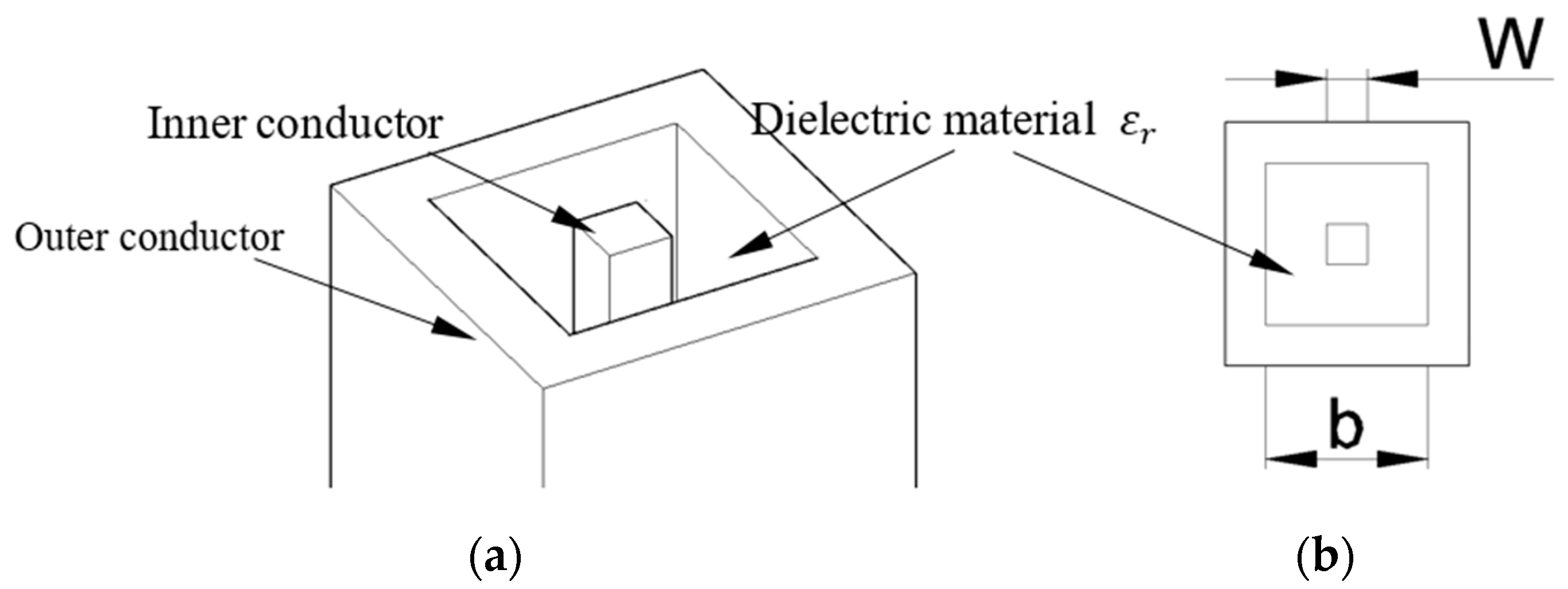
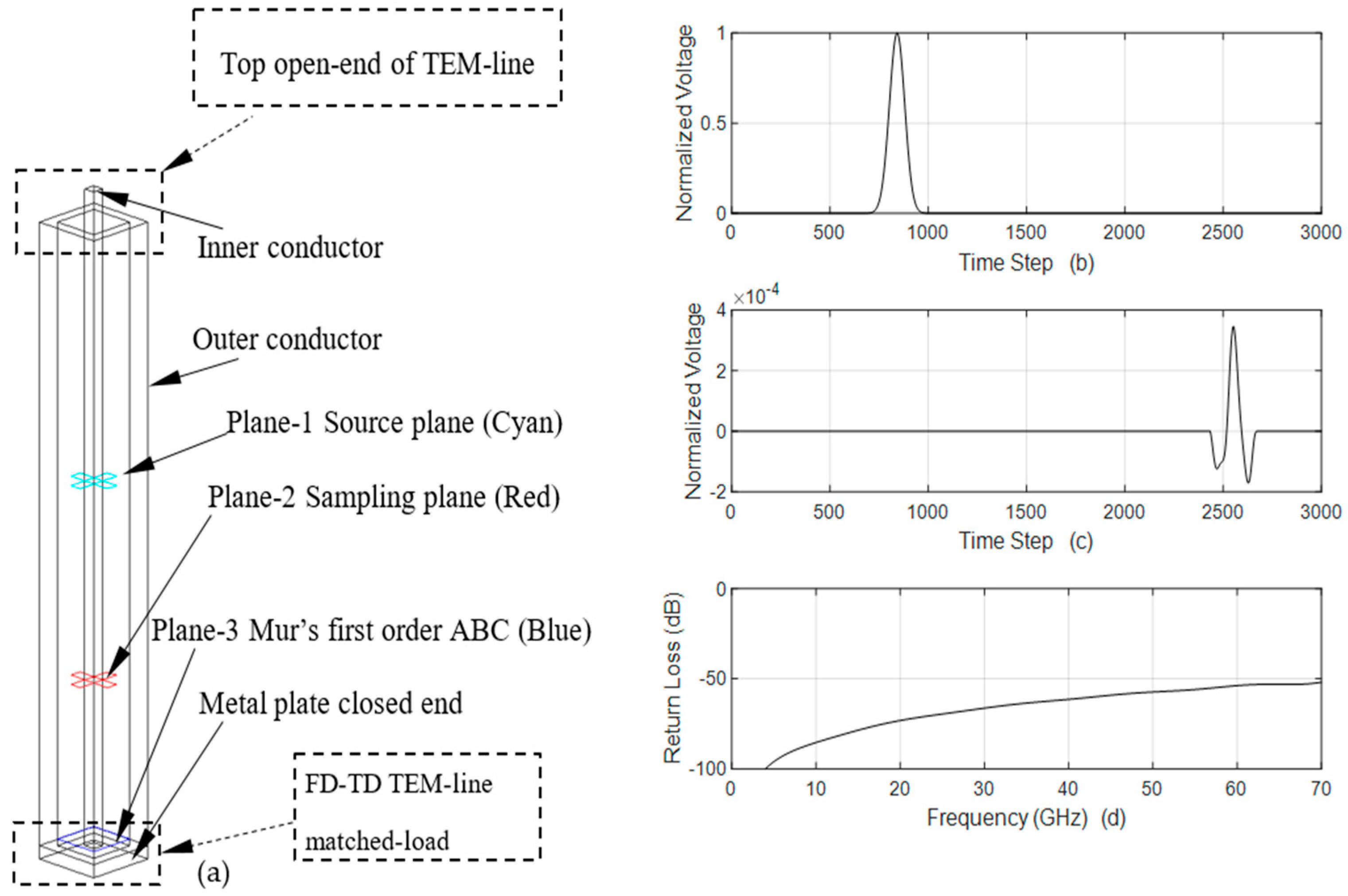
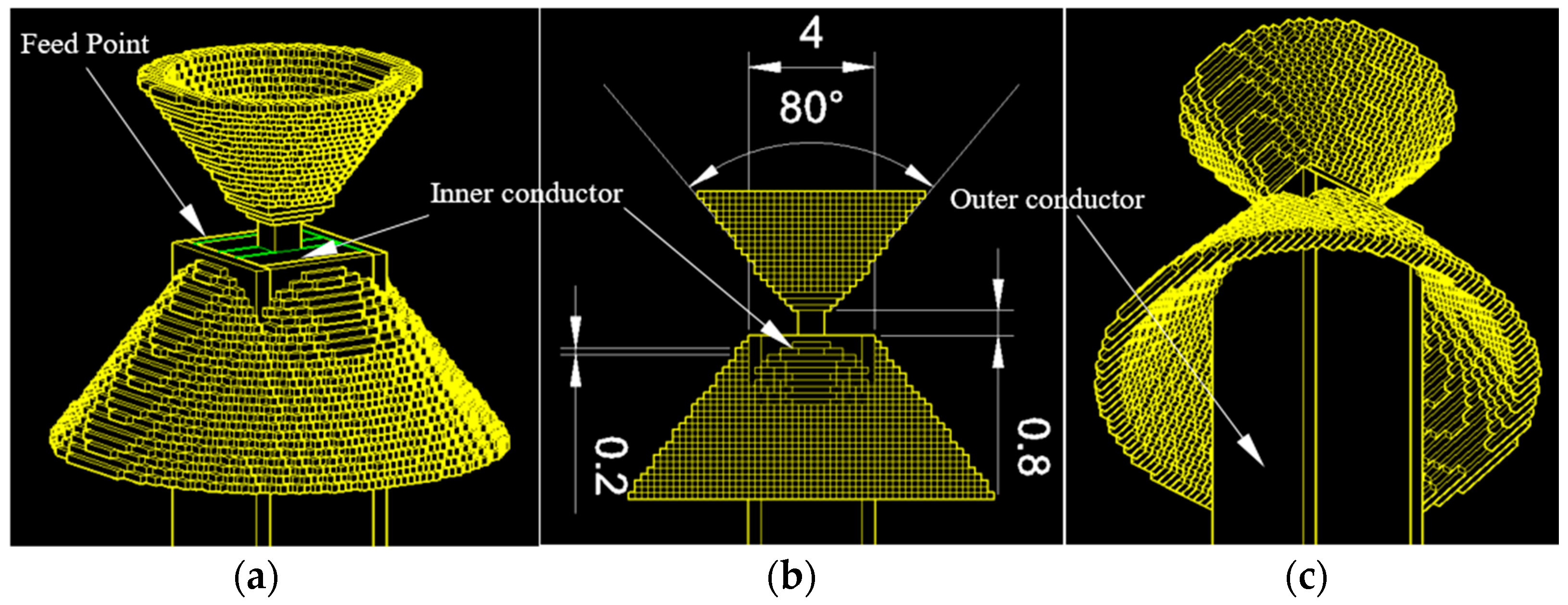
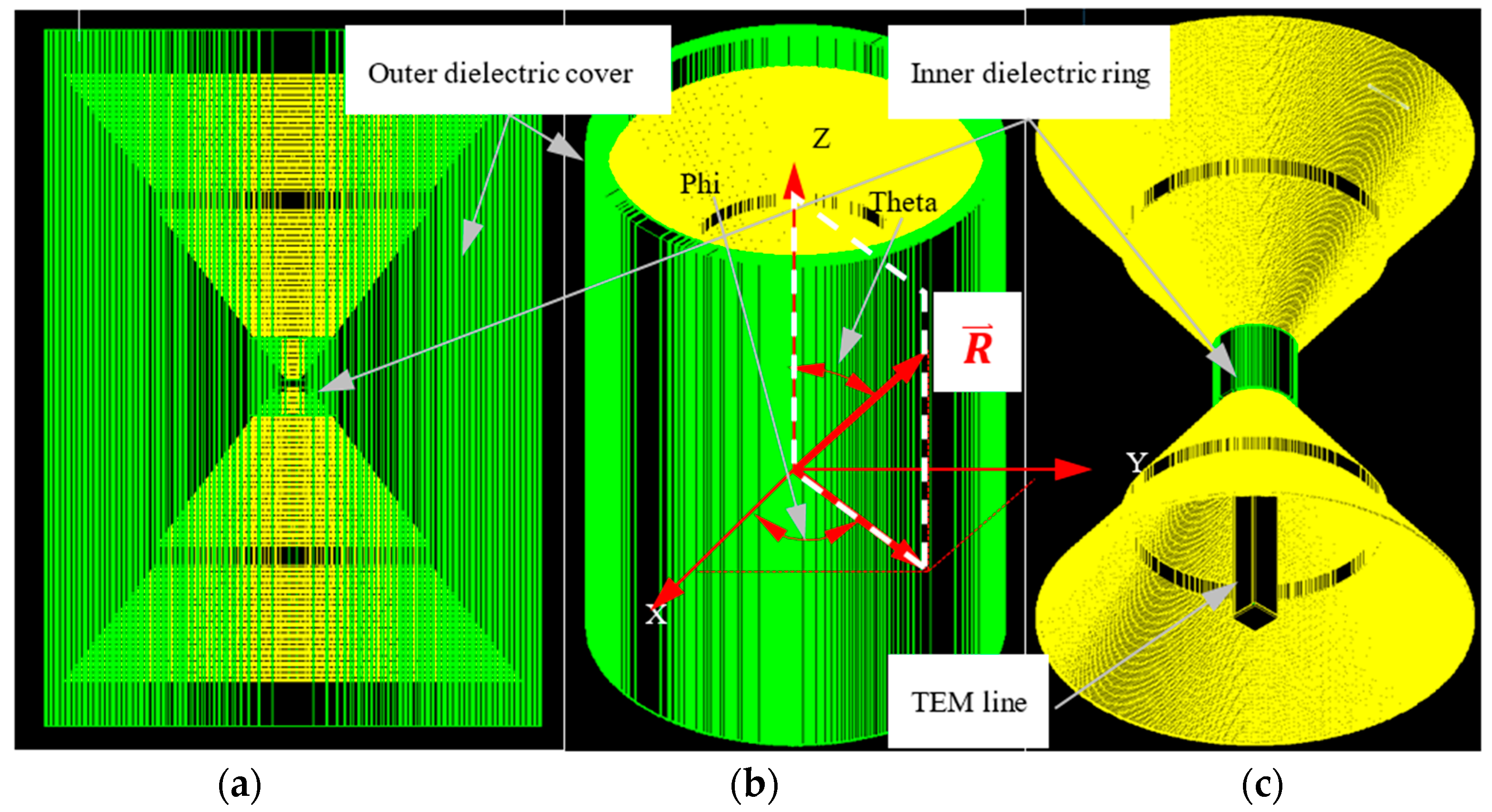
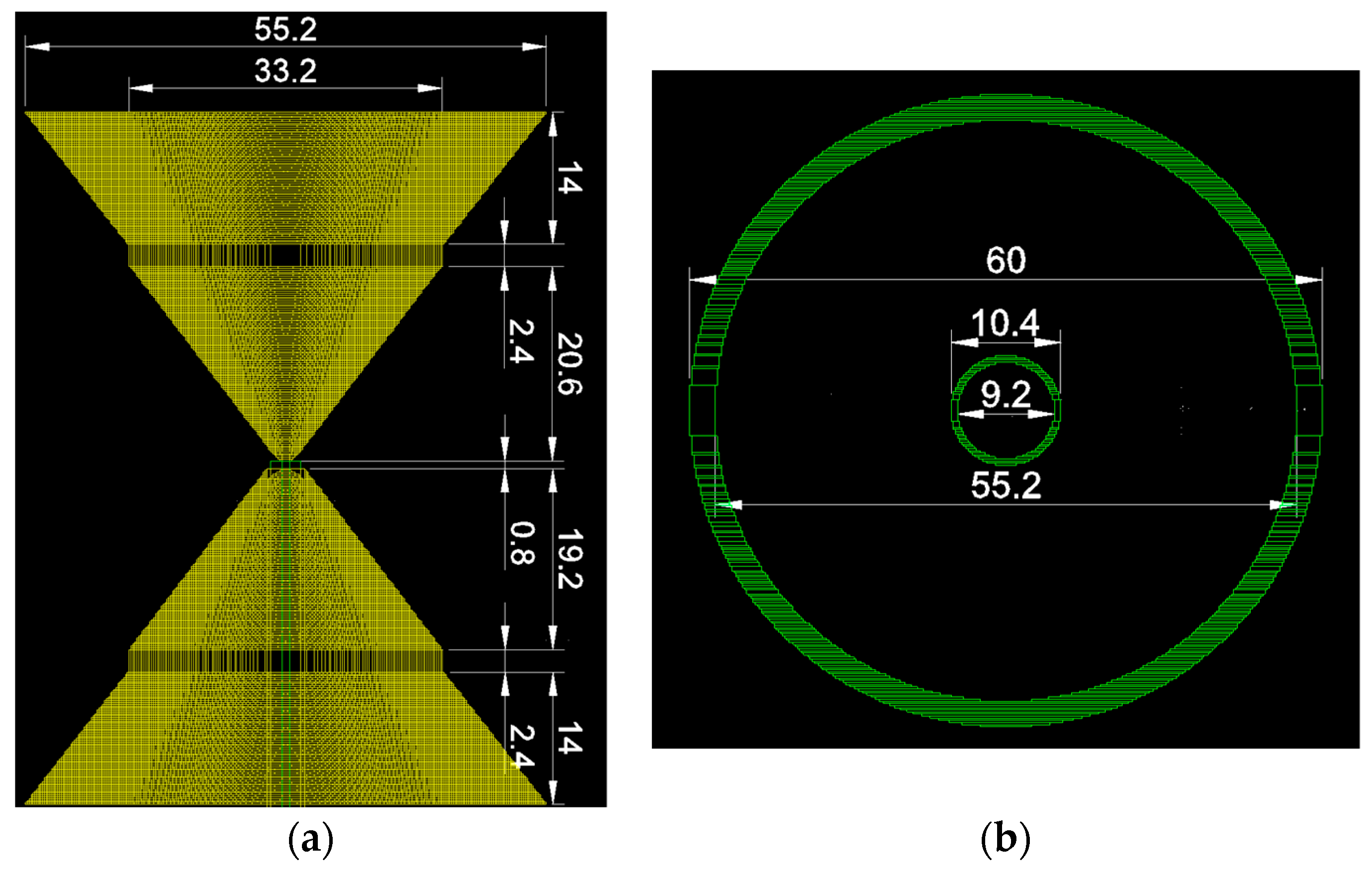
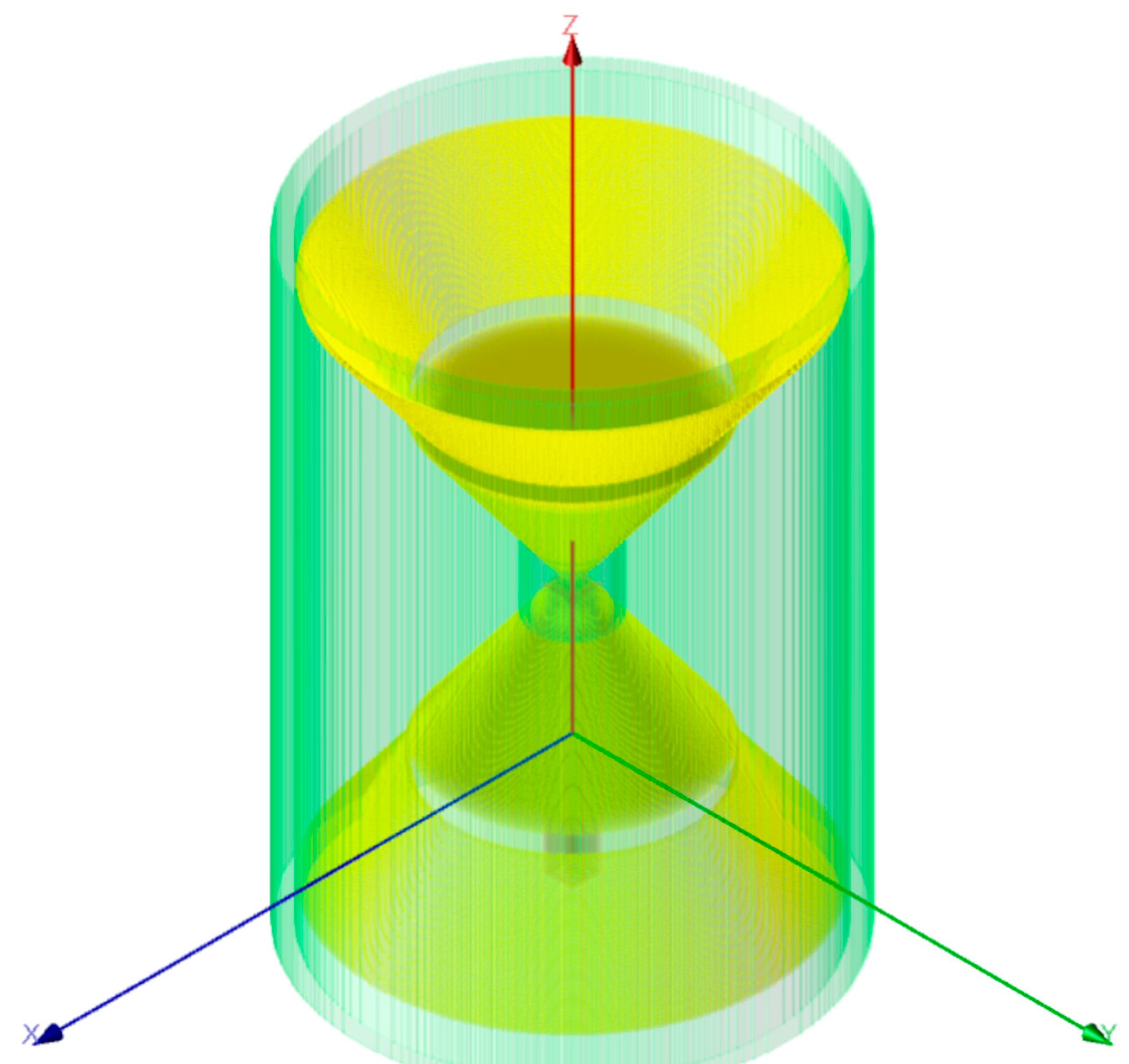
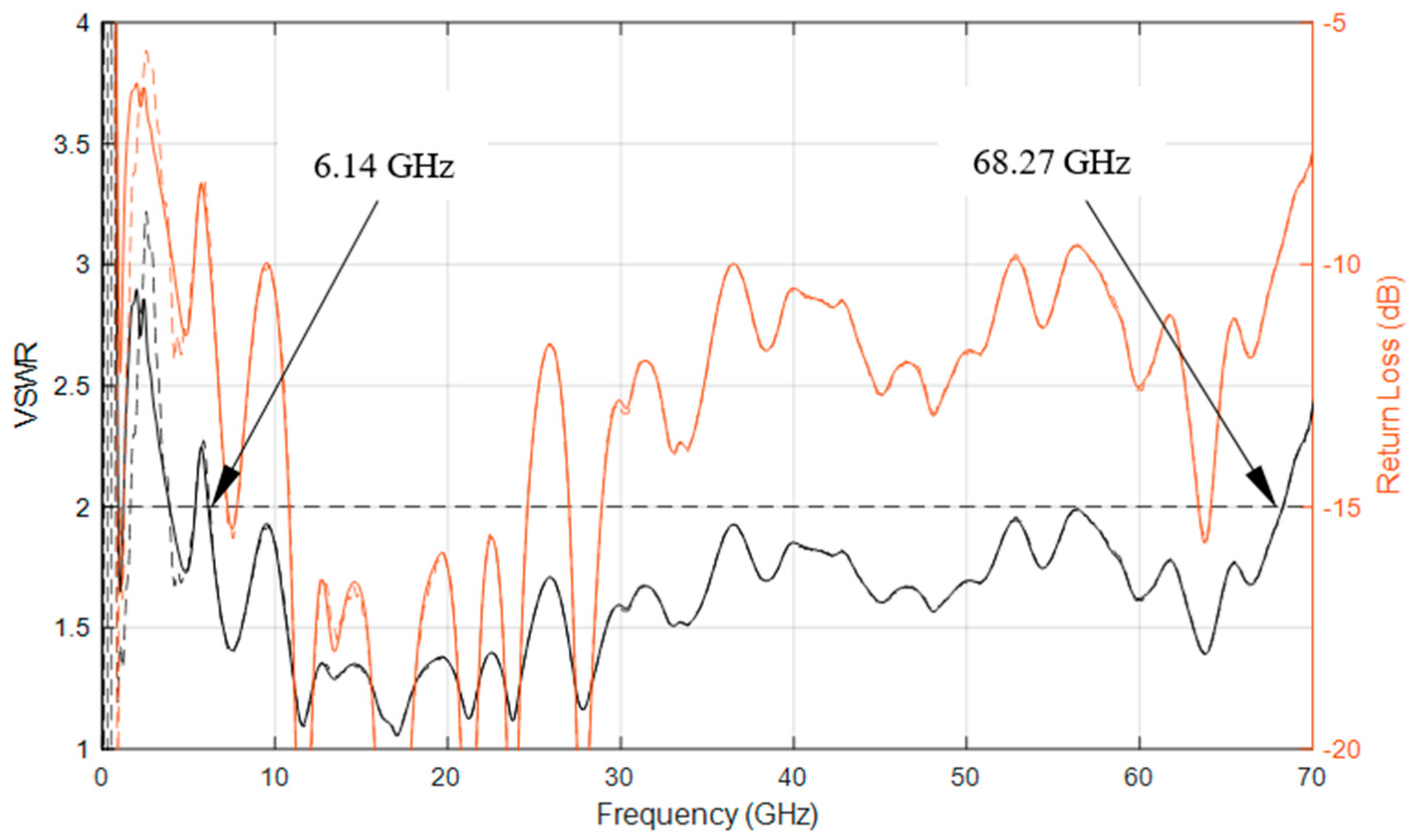
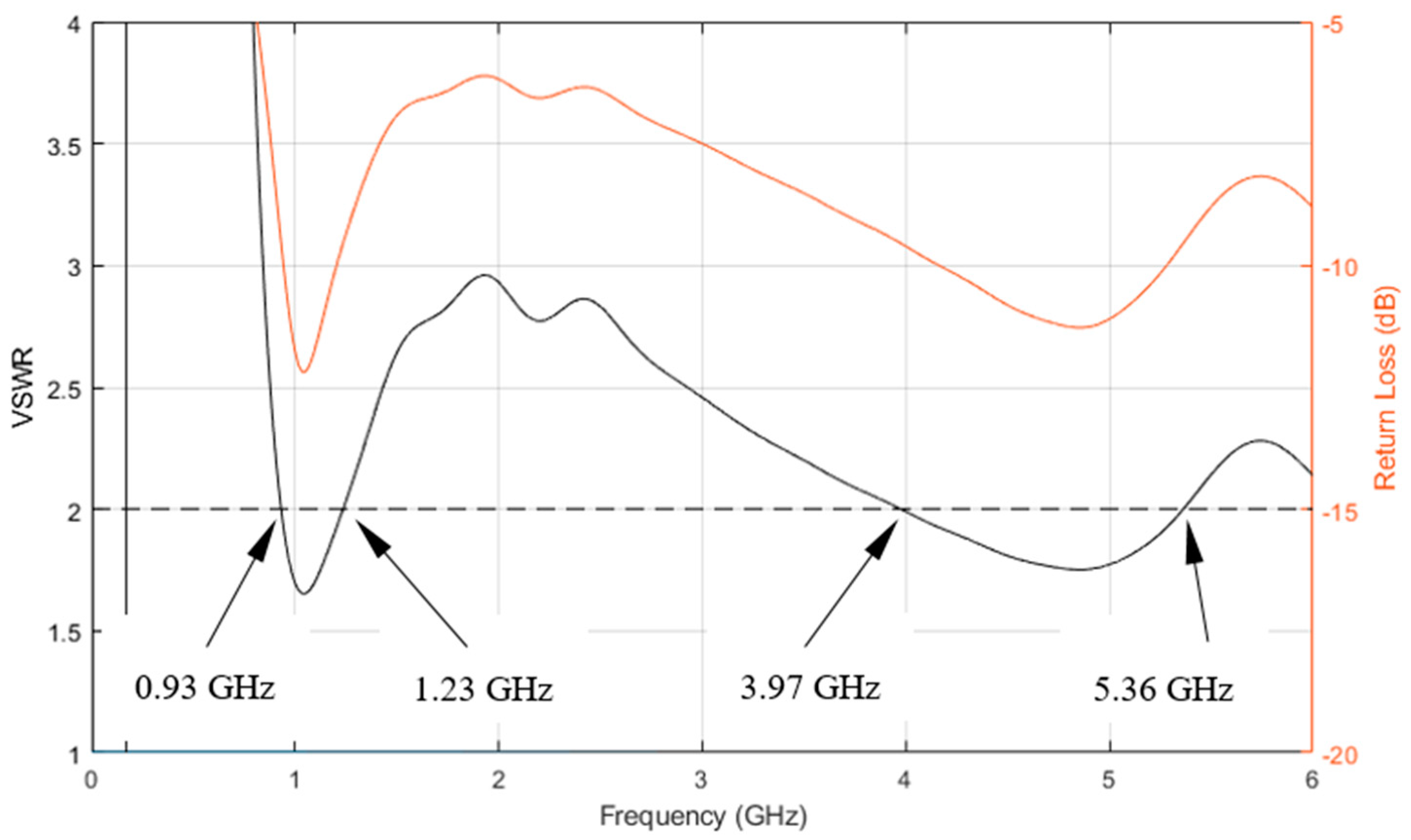

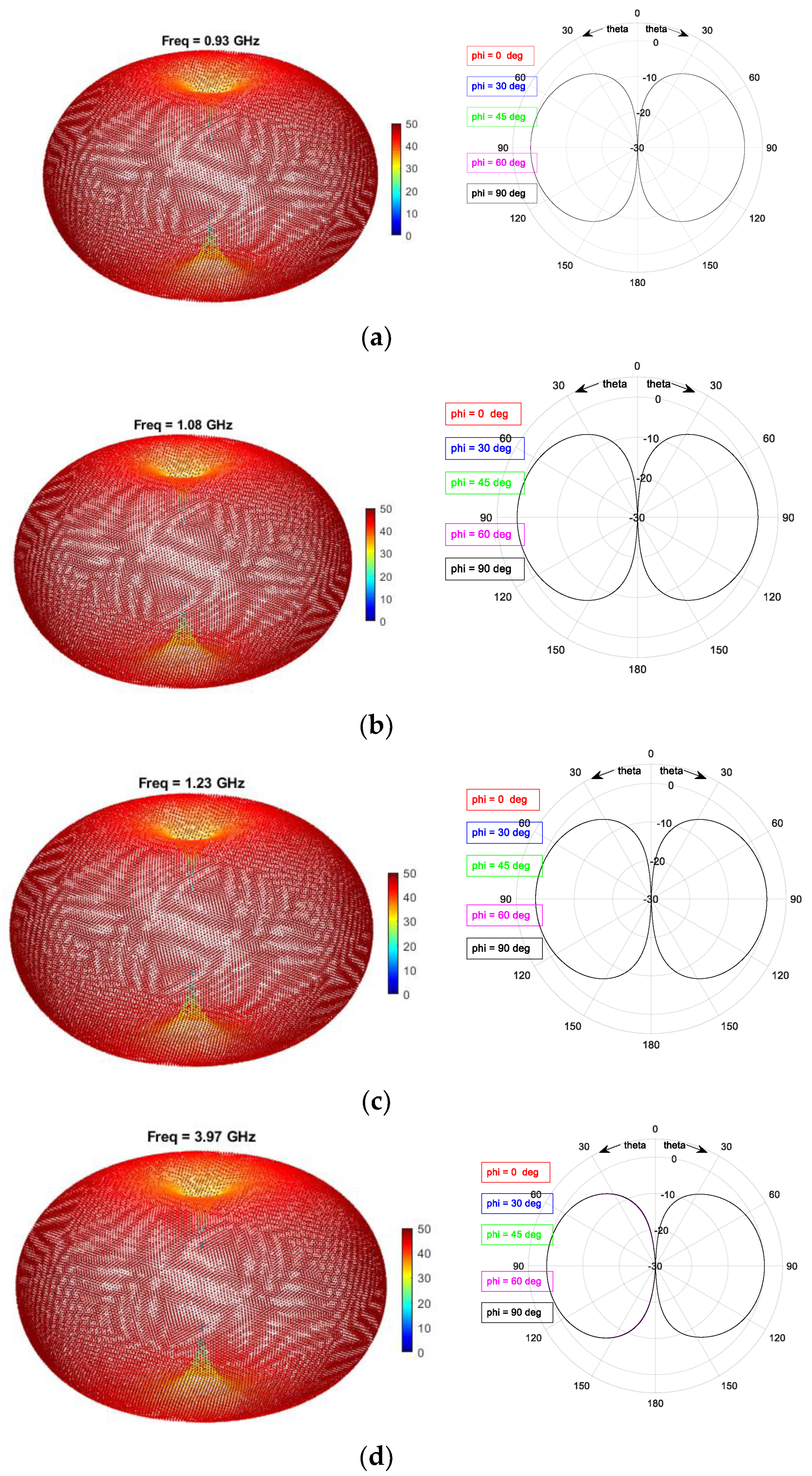
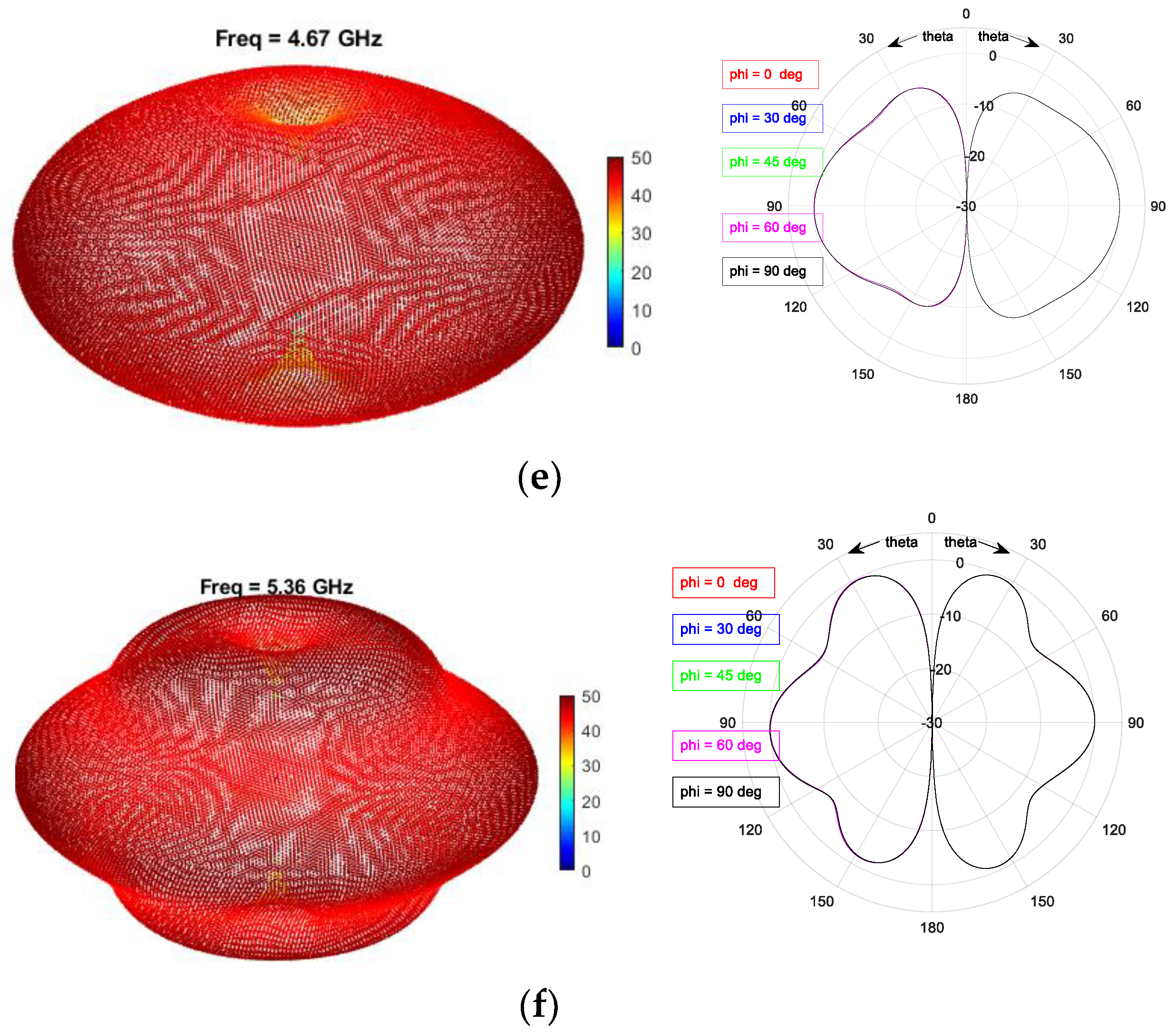
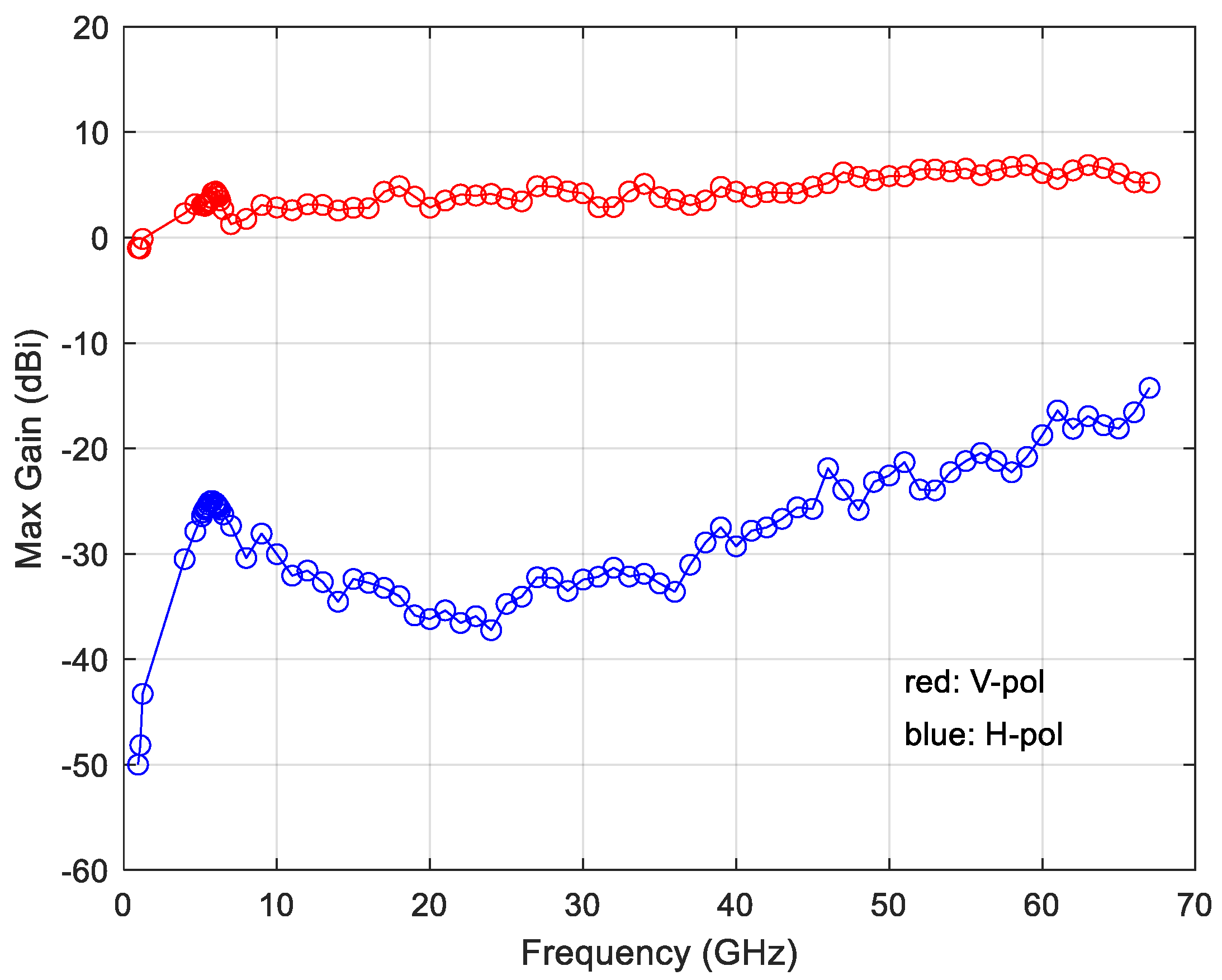
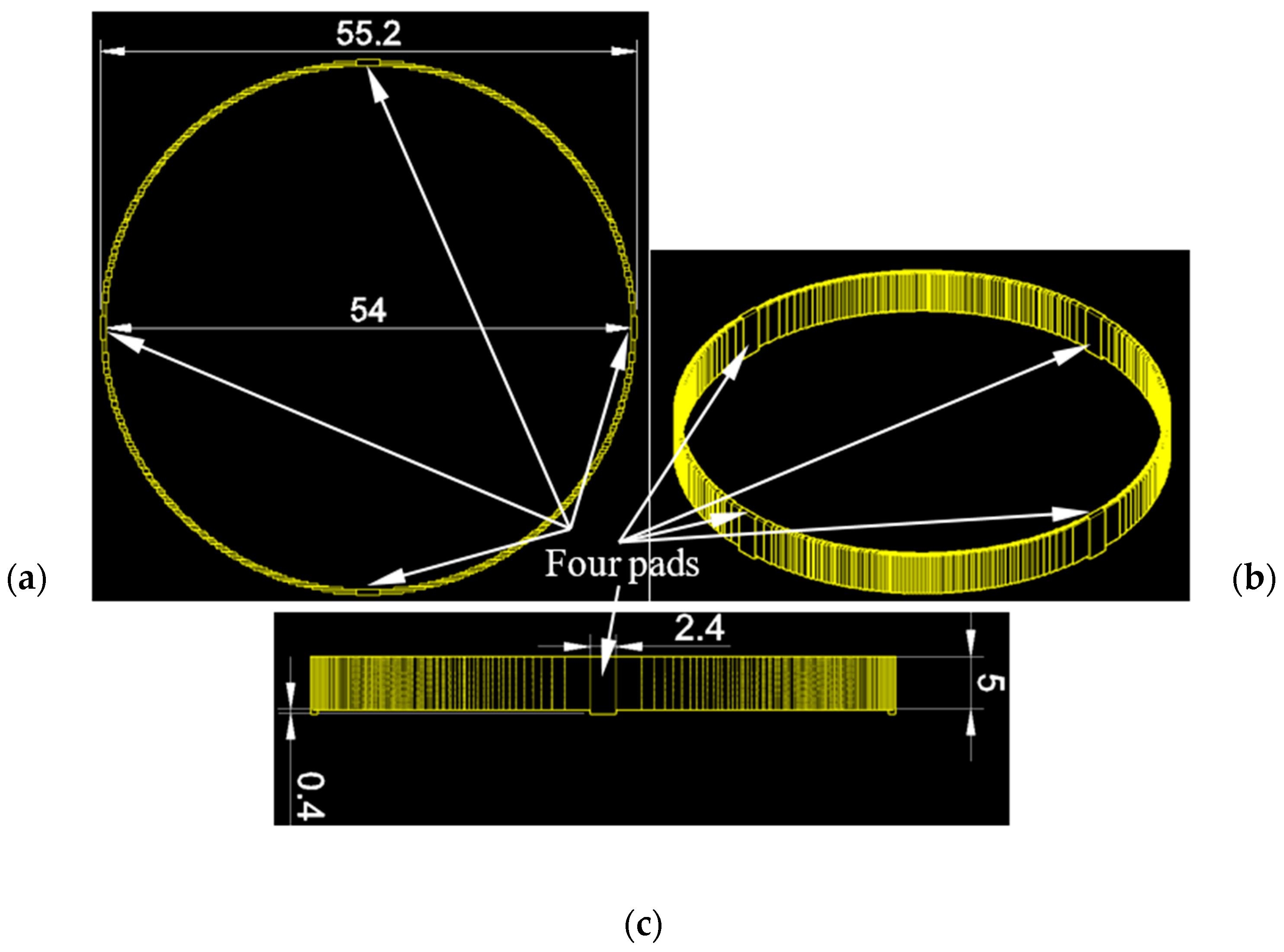
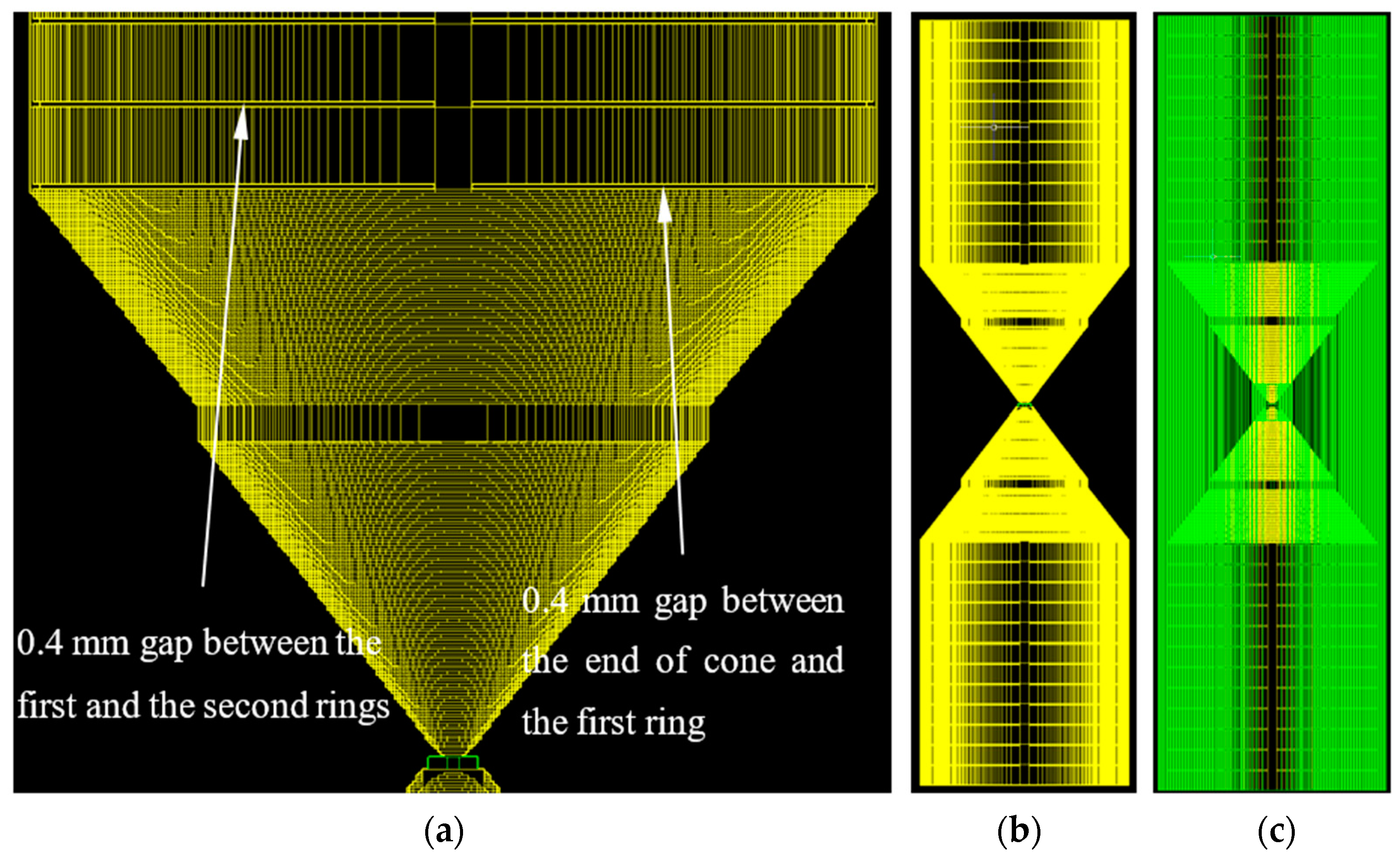
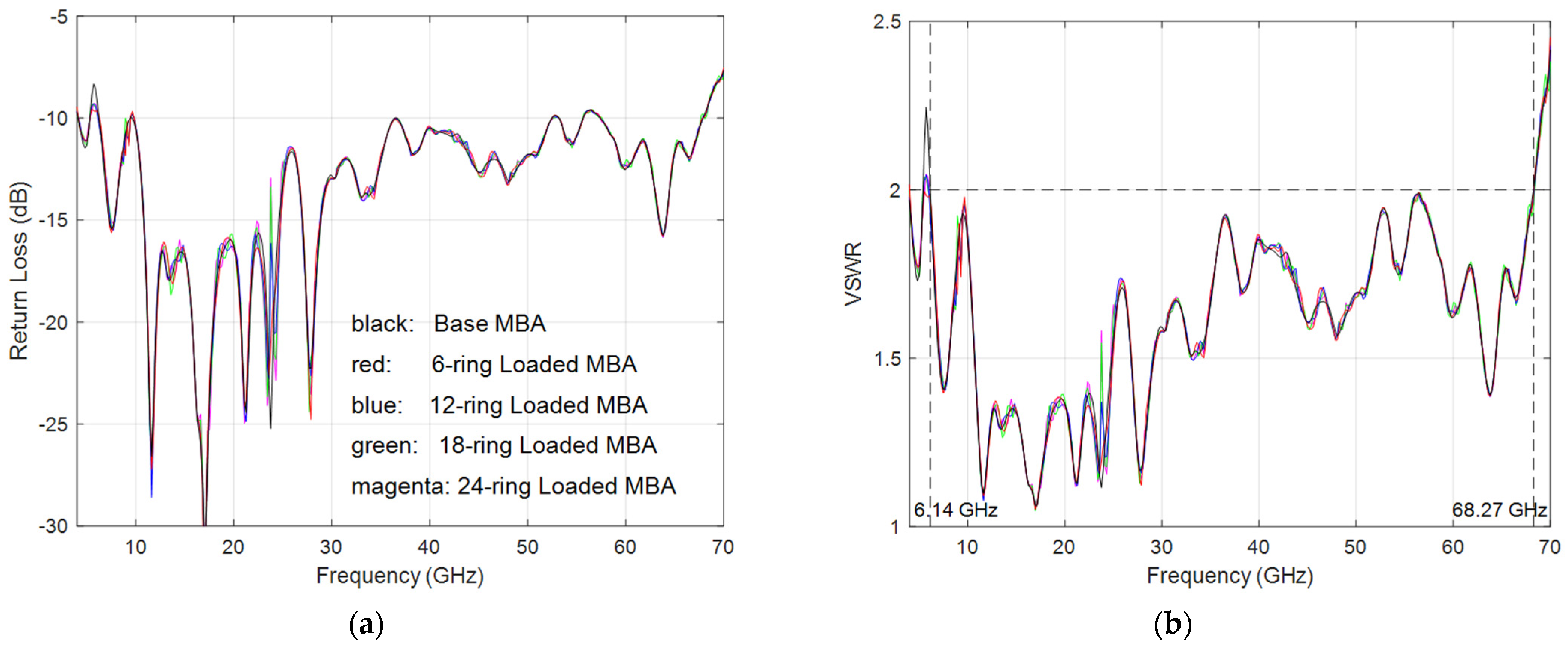
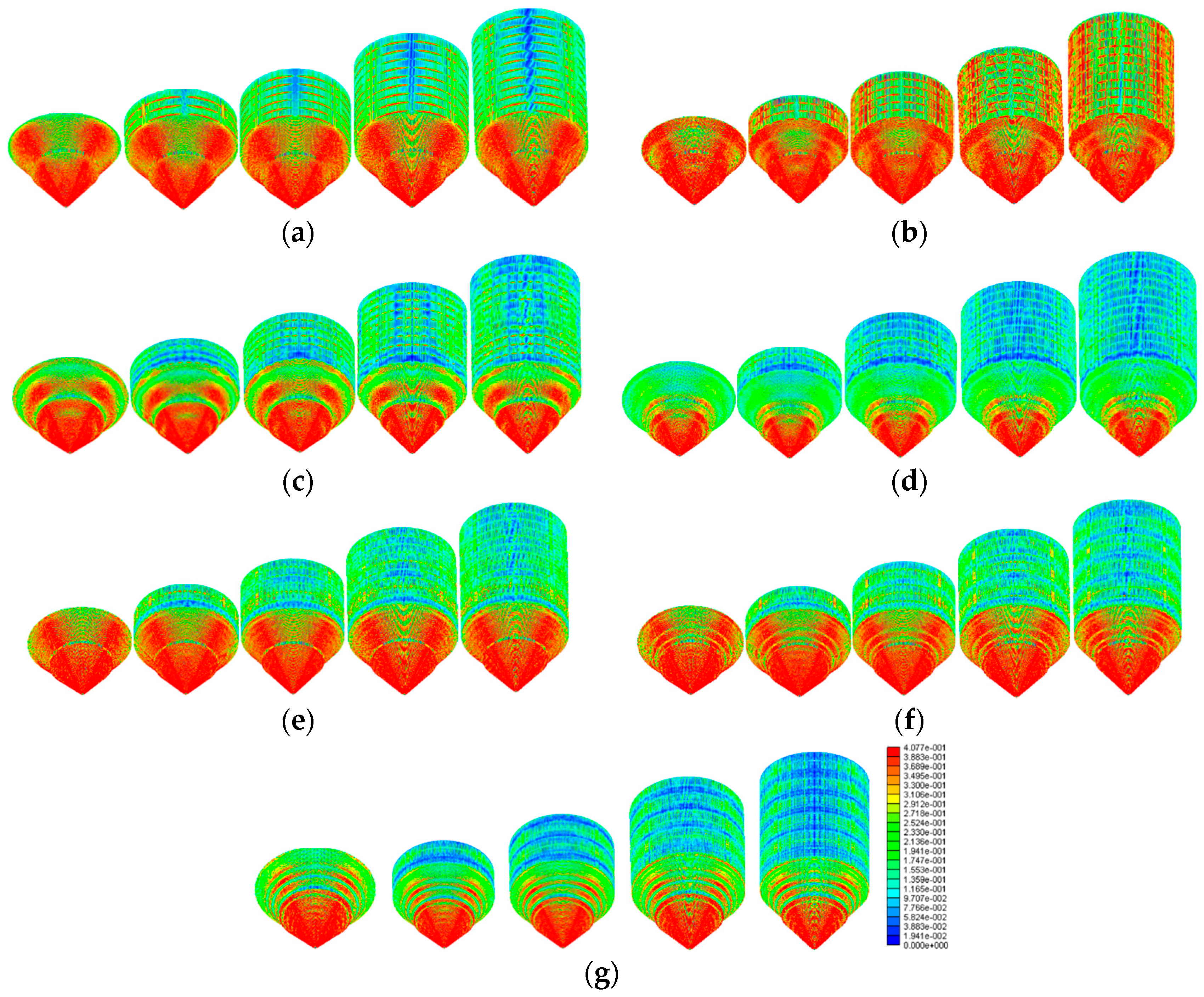
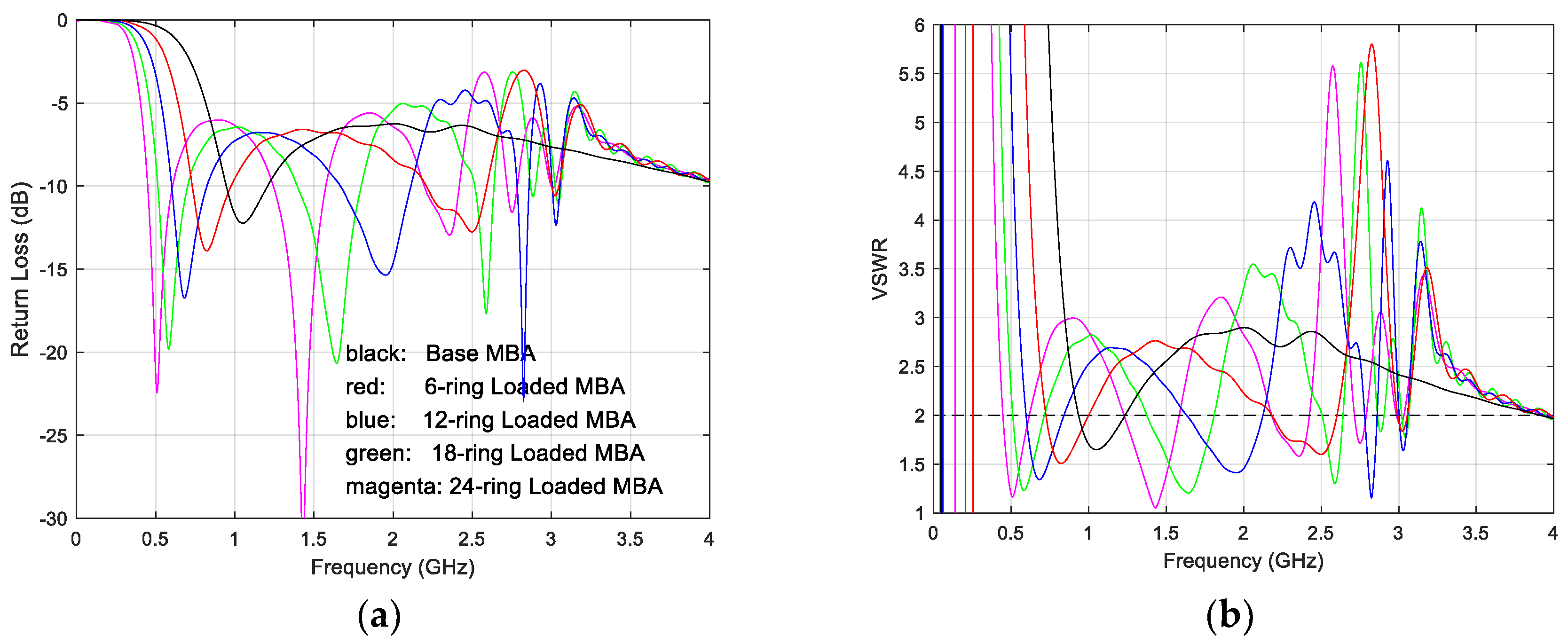
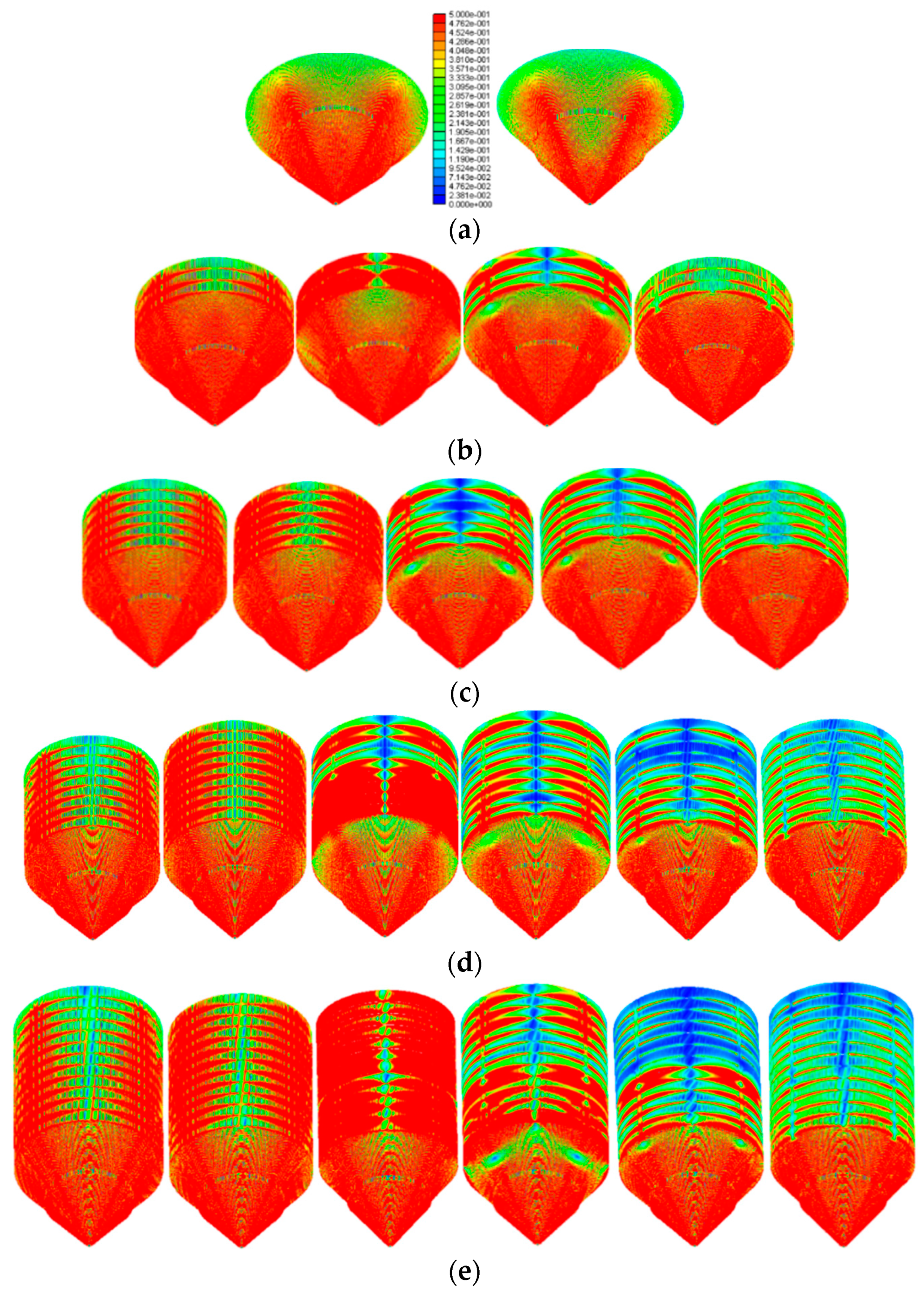
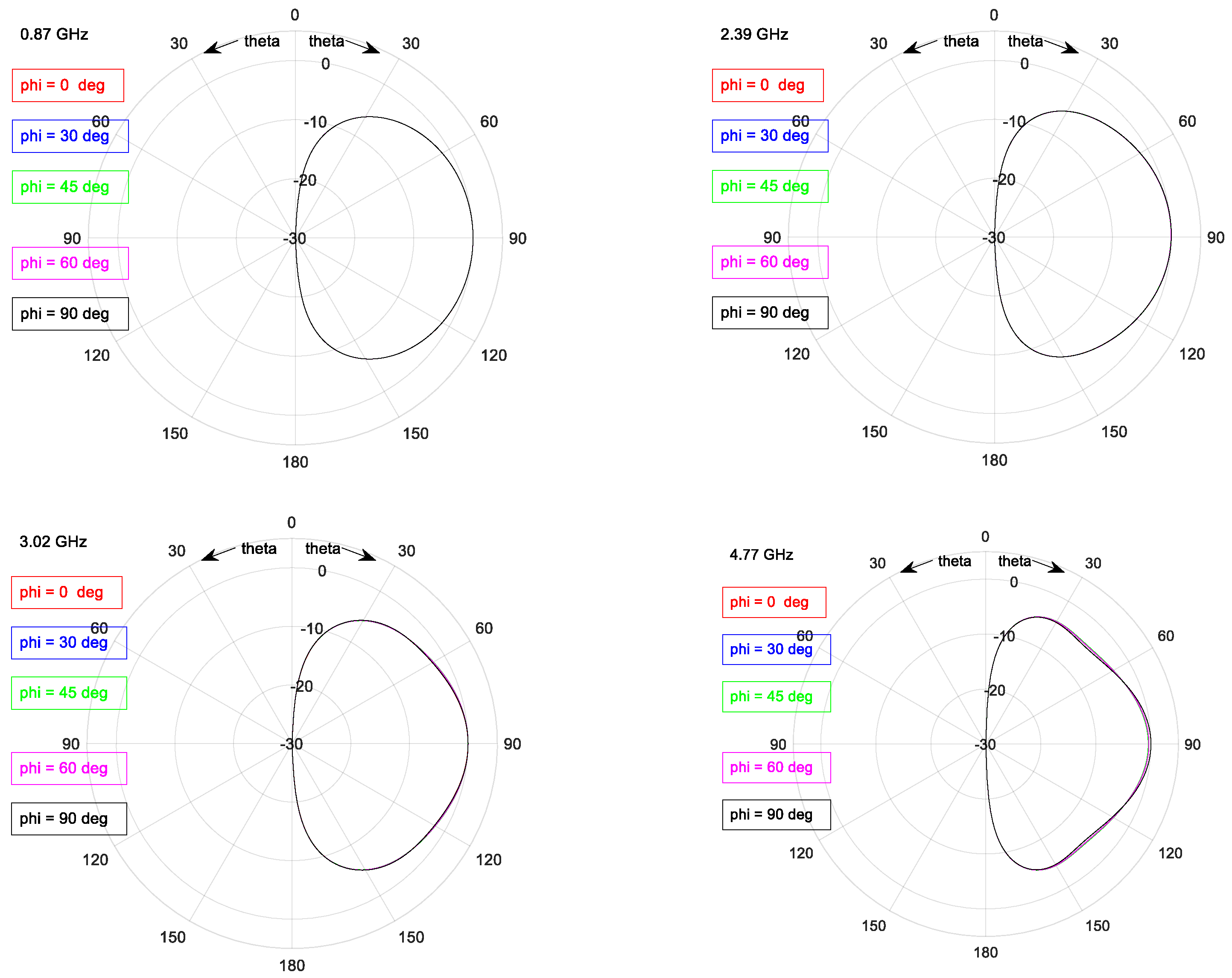
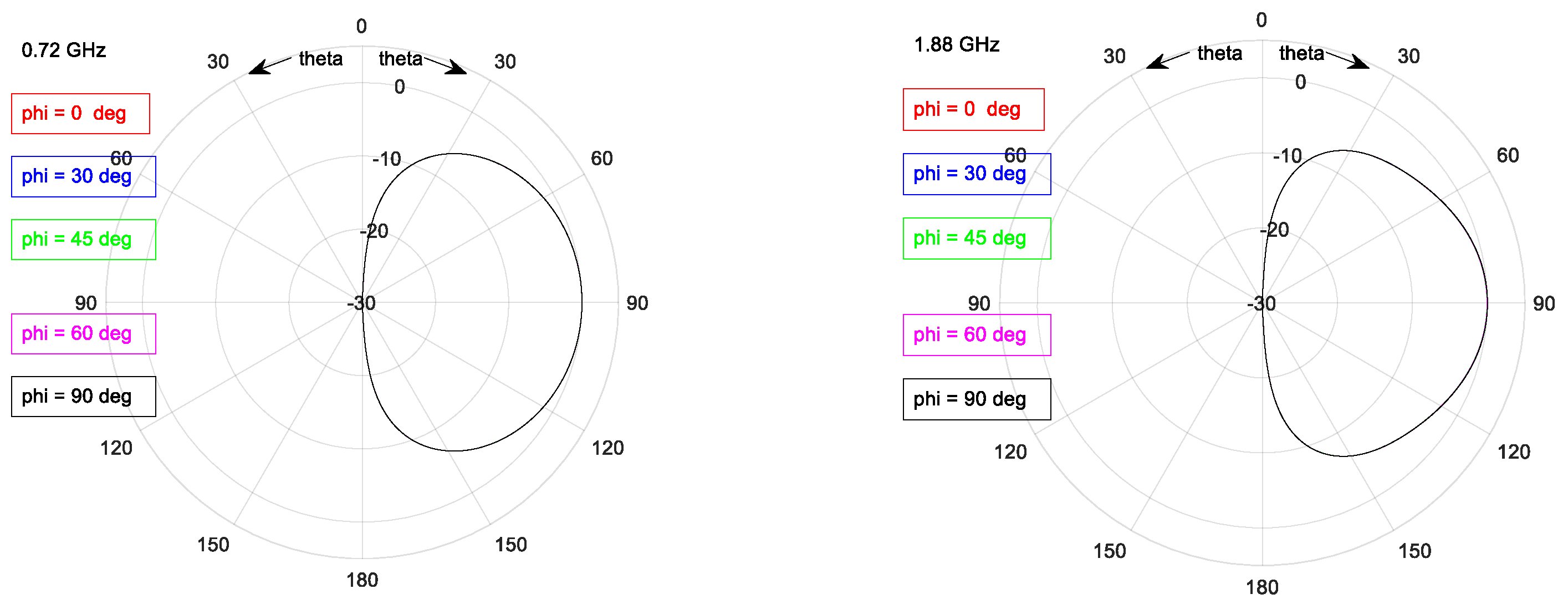
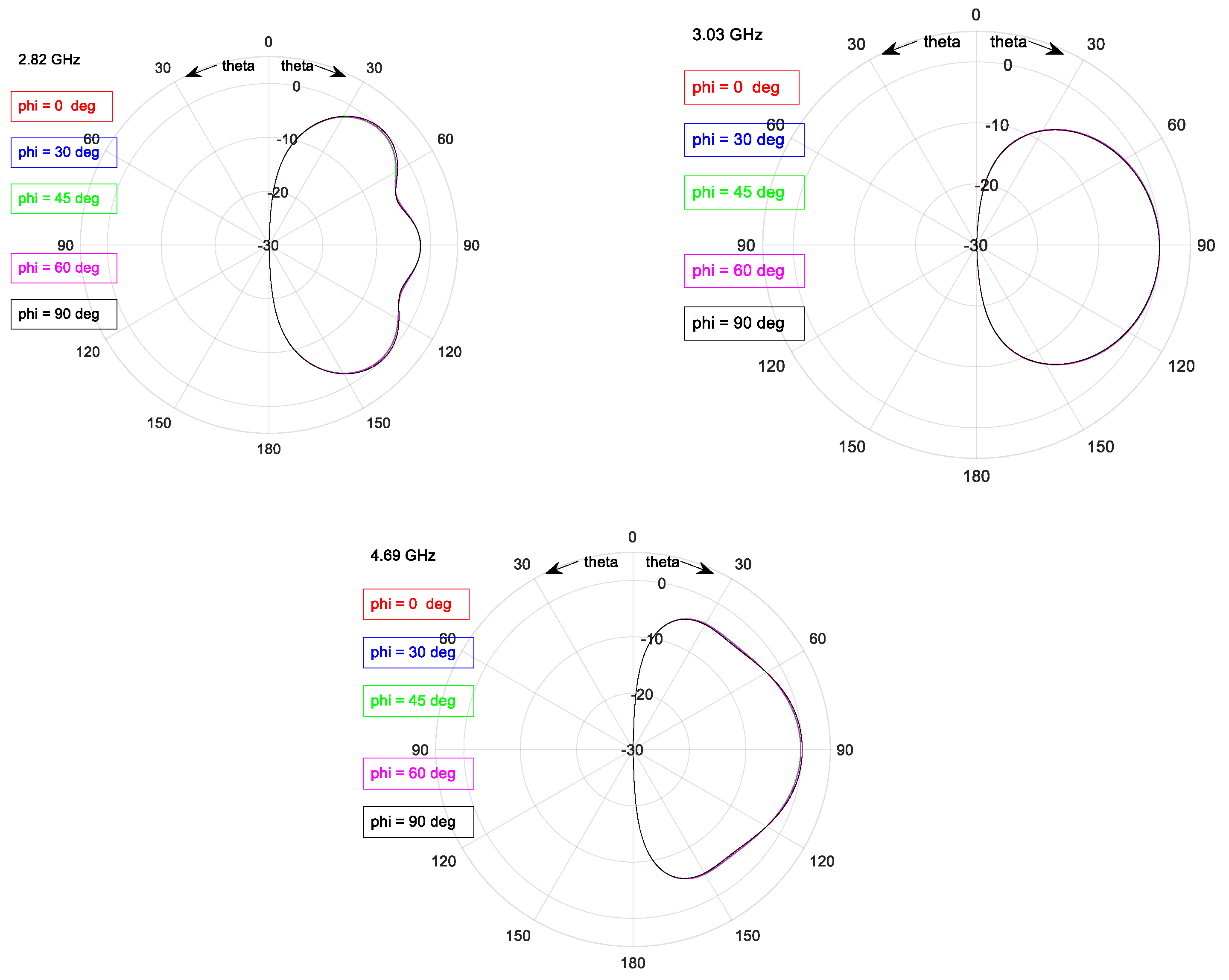
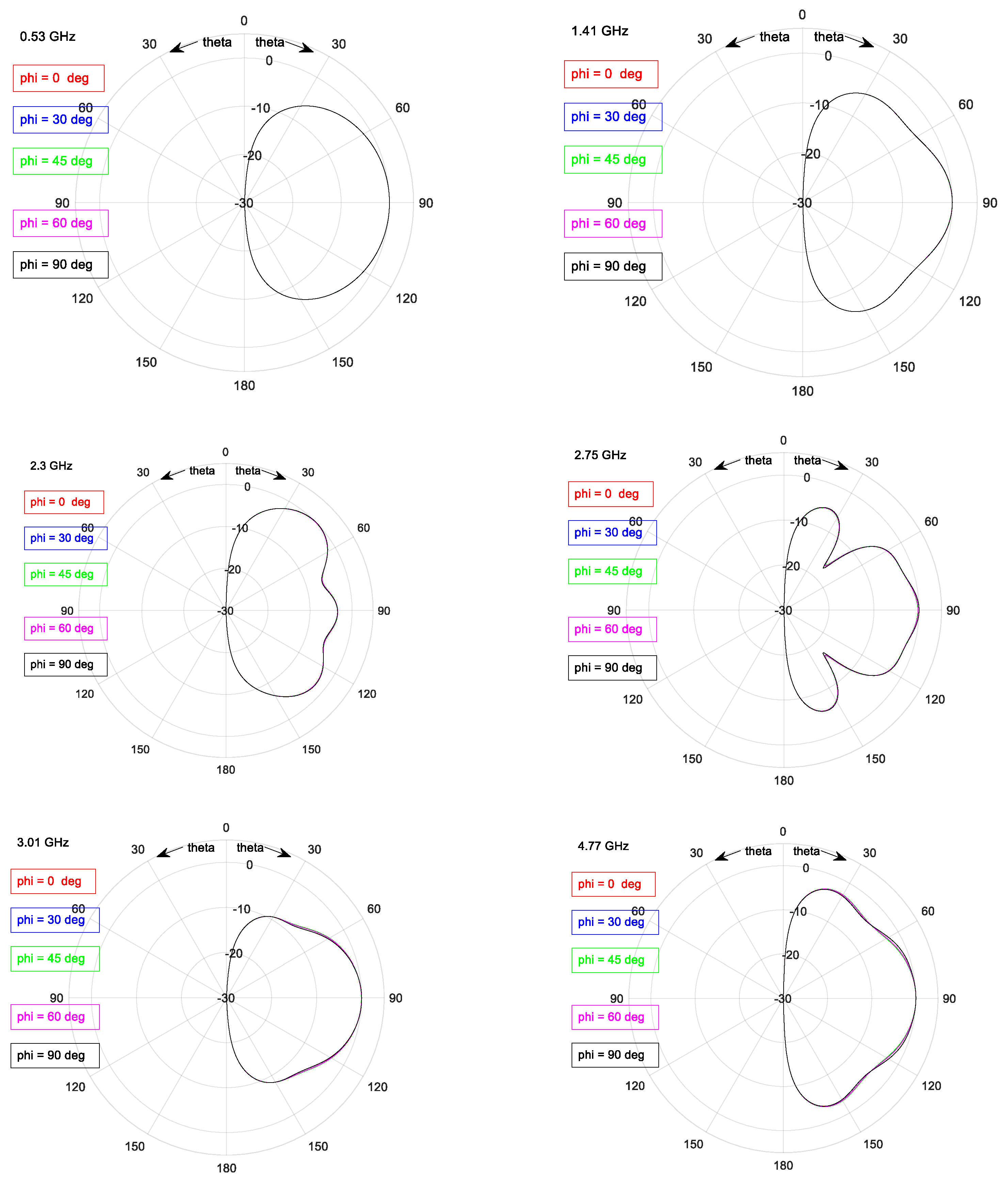
| Number of Rings at Each Side of Cone | Total Rings | Band 1 (GHz) | Band 2 (GHz) | Band 3 (GHz) | Band 4 (GHz) | Band 5 (GHz) | Band 6 (GHz) |
|---|---|---|---|---|---|---|---|
| 0 | 0 | [0.93; 1.08; 1.23] | N/A | N/A | N/A | N/A | [3.97; 4.67; 5.36] |
| 3 | 6 | [0.73; 0.87; 1.00] | N/A | [2.18 2.39 2.60] | N/A | [2.99; 3.02; 3.05] | [3.98; 4.77; 5.55] |
| 6 | 12 | [0.59; 0.72; 0.84] | [1.63; 1.88; 2.12] | N/A | [2.78; 2.82; 2.86] | [3.00; 3.03; 3.05] | [3.93; 4.69; 5.45] |
| 9 | 18 | [0.51; 0.61; 0.71] | [1.37; 1.59; 1.81] | [2.50; 2.57; 2.64] | [2.86; 2.88; 2.90] | [3.02; 3.05; 3.06] | [4.05; 4.72; 5.39] |
| 12 | 24 | [0.44; 0.53; 0.61] | [1.23; 1.41; 1.58] | [2.18; 2.30; 2.42] | [2.71; 2.75; 2.79] | [2.99; 3.02; 3.03] | [3.97; 4.77; 5.57] |
| Number of Rings at Each Side of Cone | Total Rings | Simulation Domain (mm) | FD-TD Grid Size (Including 6-Layer PML) | Total RAM (GB) | Seconds Per Time- Step | Total Time- Step | Computer CPU Model and Total RAM | Number of Cores/Logical Processors |
|---|---|---|---|---|---|---|---|---|
| 0 | 0 | 70 × 70 × 88.20 | 712 × 712 × 894 | 30.7 | 4.31 | 24,900 | HP ZBook 17 G3, Intel(R) Xeon(R) CPU E3-1535M v5 @290 GHz, 64 GB | 4/8 |
| 3 | 6 | 70 × 70 × 115.8 | 712 × 712 × 1170 | 33.6 | 6.12 | 44,300 | ||
| 6 | 12 | 70 × 70 × 148.2 | 712 × 712 × 1494 | 49.6 | 8.40 | 54,500 | ||
| 9 | 18 | 70 × 70 × 180.6 | 712 × 712 × 1818 | 64.4 | 7.07 | 64,400 | SuperMicro, Intel(R) Xeon(R) CPU E5-1630 v4 @3.70 GHz, 256 GB | 4/8 |
| 12 | 24 | 70 × 70 × 210.0 | 712 × 712 × 2142 | 86.0 | 7.41 | 77,600 |
Publisher’s Note: MDPI stays neutral with regard to jurisdictional claims in published maps and institutional affiliations. |
© 2021 by the authors. Licensee MDPI, Basel, Switzerland. This article is an open access article distributed under the terms and conditions of the Creative Commons Attribution (CC BY) license (http://creativecommons.org/licenses/by/4.0/).
Share and Cite
Wu, C.; Elangage, J. Numerical Study of Extremely Wideband-Modified Biconical Radiation Structures for Electronic Support Measures Application. Electronics 2021, 10, 369. https://doi.org/10.3390/electronics10040369
Wu C, Elangage J. Numerical Study of Extremely Wideband-Modified Biconical Radiation Structures for Electronic Support Measures Application. Electronics. 2021; 10(4):369. https://doi.org/10.3390/electronics10040369
Chicago/Turabian StyleWu, Chen, and Janaka Elangage. 2021. "Numerical Study of Extremely Wideband-Modified Biconical Radiation Structures for Electronic Support Measures Application" Electronics 10, no. 4: 369. https://doi.org/10.3390/electronics10040369
APA StyleWu, C., & Elangage, J. (2021). Numerical Study of Extremely Wideband-Modified Biconical Radiation Structures for Electronic Support Measures Application. Electronics, 10(4), 369. https://doi.org/10.3390/electronics10040369







